A



Jana F. Brown
Cindy L. Foote
Ian Aldrich
Matt de la Peña ’04 Kristin Duisberg Kate Dunlop
Ashley Festa Karen Ingraham Michael Matros
Elise Loehnen Fissmer ’98 David Foxley ’02 Dana Goodyear ’94 Jonathan Jackson ’09 Malcolm MacKay ‘59 Diego Nuñez ’08
Published by
Trustees of St. Paul’s
SPS alumni traveled to the School for Anniversary Weekend to reconnect and celebrate the return of in-person festivities.

COVID-19 has only exacerbated the teen mental health crisis in America. Here, alumni thought leaders weigh in on the topic.

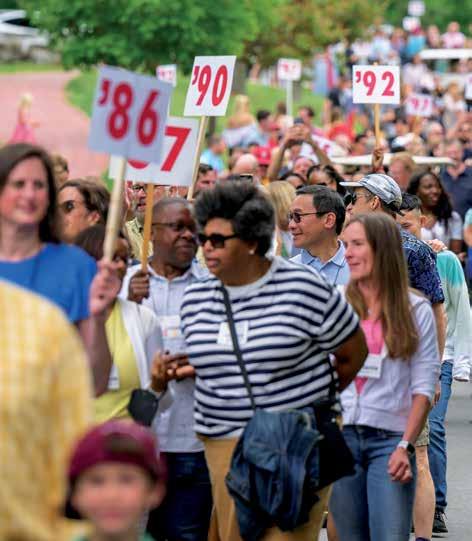
Alumni and their guests were all in at the first in-person Anniversary Weekend since 2019.
PHOTO: Jeremy Gasowski
David Scully ’79 becomes new Board president, Shattuck Fellows, meet students Finn Goss ’22 and Eden Wright ’22, tracking college admissions, graduation of the Form of 2022, honoring retiring faculty members and a 25-year career milestone.
Dbury@50: The Complete Digital Doonesbury Garry Trudeau ’66
Celia Aniskovich ’10 discusses her podcast series, Spy Affair.
Brent Scudder ’56 is too busy to be bored — he has tornadoes to chase.
Sabai co-founder Phantila Phataraprasit ’12 is building a sustainable furniture company that does not sacrifice her customers’ values.
Alumni gather for SPS Sparks Days of Service and the XIX Society Global Seated Meal.
With Alumni Relations Director Stephen Donovan.
In the midst of the Russian invasion of Ukraine, journalist Brett Forrest ’91 found himself on the front lines of the conflict.

With the startup satellite company Hydrosat — and its thermal imagery
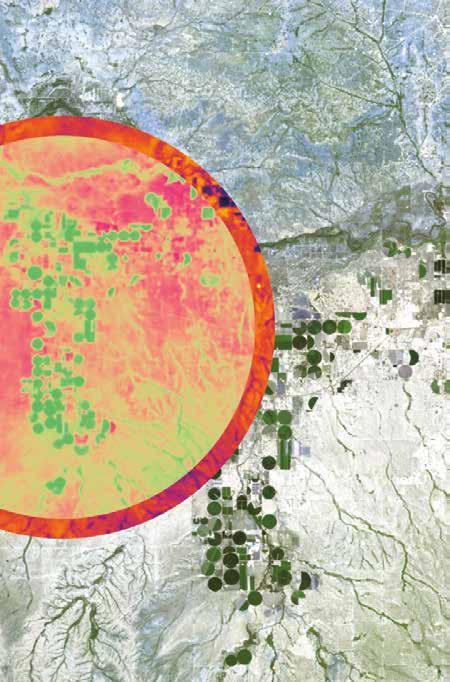
— Pieter Fossel ’10 is helping to map climate change.
Do you receive email communications from SPS? If not, we may not have your current address on file. To update your email, please write to alumni@sps.edu. Thank you.

In the spring, I attended a memorial service for Trustee Andy Baxter ’60 (obituary, page 61), at which a member of his form, prior to reading our School Prayer to conclude the service, explained to the assembled group that St. Paul’s School graduates learn this prayer as stu dents and regard it as a lifelong beacon for how to live and how to treat others. The group, which included many SPS alumni, then recited the prayer together:
“Grant, O Lord, that in all the joys of life we may nev er forget to be kind. Help us to be unselfish in friend ship, thoughtful of those less happy than ourselves, and eager to bear the burdens of others; through Jesus Christ our Savior. Amen.”
As I have reflected on that experience and how much positive energy was generated in that moment, another pow erful rendition comes to mind — one offered by the young boys of the Bishop John T. Walker School for Boys in Washington, D.C., during my pre-pandemic visit in early 2020.
Founded and named in honor of our first African American faculty member, The Right Reverend John Walker, this elementary school is well known to our SPS community, as is the beloved and revered person for whom it is named. This school states its mission as fol lows: “A tuition-free Episcopal school for boys, striving to alter the educational and social trajectory of children from traditionally underserved communities, preparing them for leadership and service in their communities and well beyond.”
Hearing these young boys recite this prayer will stay with me for the rest of my life. Along with the Episco pal Diocese of Washington, our St. Paul’s community is deeply invested in the support and growth of these young boys. Every year, we send a group of St. Paul’s students and faculty to the school to serve and, importantly, to be inspired. That this community, bearing so many burdens of its own in the forms of racism, poverty, crime, and ur ban blight, comes together to teach its most vulnerable children to know in their hearts this prayer speaks to its true meaning.
Our School Prayer has no qualifiers and comes from the tradition that requires us to recognize that everyone is our neighbor and that we love our neighbor as ourselves. It demands that we are unselfish, compassionate, and em pathetic with those around us. As culture wars rage and accusations of “wokeness” fly, our Beloved Community needs to stand strong with our School Prayer and, in the words of our graduate at Andy’s memorial service, use it as a beacon for the way we live in the world and how we treat others — without qualification.
The practical effects of doing this can give us pause. It will not always feel good to do good and be good. It is certain at times we will not find our neighbor as lovable or as deserving as we find ourselves. Yet, it is important to acknowledge that the joys of our lives are extraordinary and the burdens of others — not our interest, but their burdens — require our attention and commitment. Our School Prayer insists we do not localize or limit the reach of our unselfishness, compassion, and empathy. These values are the ways we interact with the world and require constant work over our lifetimes. They are the beacon by which we orient and reorient ourselves (even when we fail) without qualification for whose friendship we need to be generous, for whom we need to be thoughtful, or for whichever neighbor’s burden we need to bear.

Established five decades ago and named in honor of the founder of St. Paul’s School, George Cheyne Shattuck Fellowships represent the highest distinc tion that can be bestowed upon an SPS community mem ber by the Rector of the School. It is an honor so exclusive that only 21 Shattuck Fellows were named between 1977 and 2016. This spring, 14th Rector Kathy Giles added two more names to that list as she awarded the first Shattuck Fellowships of her tenure to outgoing Board President Archie Cox, Jr. ’58 and former trustee Sarah Bankson Newton ’79, whose Fel lowship was bestowed posthumously.
Cox received his honor at the April Board of Trustees meetings. In reading the citation, Giles named the qualities of a Fellow: “For contributions to humanity through a life of unbounded devotion and loyalty, for generously sharing ‘the love and labor of many,’ for assuring this school more strength to toil, more years to strive … and a person worthy of our highest graces.”
Cox was completing a decade of service as an SPS trustee, during which he sat on five committees, includ ing serving as chair of the Audit and Risk Committee, before assuming the role of president in July 2016. In re marks made at the April meeting, Board President-elect David Scully ’79, P’21 honored Cox’s commitment to SPS.
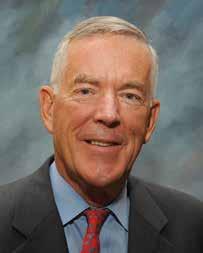
“Such dedication … is rare,” Scully noted. “You have set an example for all of us. During some very demanding years, you engaged with your fellow alumni and ensured all voices were heard. This took fortitude. There were some tough decisions that had to get made, and you never shied away from making them.”
In closing, Scully noted Cox’s hours of service to the School would be “impossible to quantify” and called him “one of the School’s most devoted alumni.”
During Anniversary Weekend, Giles recognized for mer trustee Sarah Bankson Newton ’79, who died from a tragic accident in May 2021. Fittingly honoring Bankson Newton at the June 11 closing event for the School’s year long celebration of coeducation, Giles described her as “one of our pioneers and stalwart leaders” who, from an early age, “nurtured in her spirit a principled love for the people of this place and an understanding of the impor tance of schools in children’s lives.”
A longtime volunteer for St. Paul’s and a self-described “den mother” to her “130 brothers and sisters” in her SPS form, Bankson Newton also gave of herself to many other people and missions she held dear, including Esperanza Academy, a school for girls from low-income families in Lawrence, Massachusetts.
In a tribute to Bankson Newton after her death, the school’s head, Jadi Taveras, described her as their “guid ing light” and credited her leadership with mak ing the school “as strong as it has ever been.” She added, “In a world where children of color are fac ing the unfair burdens of systemic racism, Esper anza stands apart — and so much of the credit goes to you.” Bankson Newton had been the school’s board chair at the time of her death and active in its establishment and growth over the last sev eral years.
As Giles closed her remarks, she noted, “Sarah’s hand will be felt for generations through the change she has created in the lives of these young women and for all of us touched by her warm, kind brilliance.” After sharing some remembrances of her mother, Bankson Newton’s daughter, Avery, accepted the award on her behalf.
 KAREN INGRAHAM
TIERNAN
KAREN INGRAHAM
TIERNAN
On July 1, David Scully ’79, P’21 began his term as the new Board of Trustees president for St. Paul’s School — an appointment announced in May by Rector Kathy Giles and outgoing Board Presi dent Archie Cox, Jr. ’58, who retired from the Board after 10 years of service.
In a letter emailed to alumni, parents, and employees, Scully expressed how honored and excited he felt about the opportunity, noting “the need has never been greater to educate and inspire a new generation of ethical citizen leaders. This is what we do at St. Paul’s School.” He added:
The values embedded in our School Prayer have always spoken to me: kindness, compassion, humility, and service. These values are learned in the classroom, on the athletic field, and in the myriad other interactions that occur every day in our fully residential commu nity. Our students confront challenges and evolve approaches to overcome them, as individuals and as teams. They learn that grit and perseverance lead to good outcomes. These values have been my North Star. I think they are more relevant today than ever.

A trustee since 2020, Scully chairs the Finance Com mittee and sits on the Executive, Grounds and Buildings, and Investment Committees. He has been an active SPS volunteer in a variety of capacities for many years, serv ing as a form agent (1989-95 and 2005-09) and main agent (2009-14). His SPS connections include his father, John A. Scully ’49; uncles, Scott W. Scully ’40 and David W. Scully ’45; brother, Benjamin P. Scully ’82; and cousin, Jamie Purviance ’81. His son, Benjamin W. Scully, is a member of the Form of 2021.
Scully is currently vice chairman at Caledonia Investments, a global investment management firm with offices in Sydney and New York. Prior to Caledonia, he was a partner and chief marketing officer at Coatue Manage ment, a hedge fund focused on technology, media, and telecommunications. He joined Coatue in 2005 after working in a similar capacity at Passport Capital and Cannell Capital, two long/short equity hedge funds based in San Francisco. He is board chair of the Woods Hole Oceanographic Institution, a fellow of the Royal Geo graphical Society, and has served on Trinity College’s Board of Fellows.
As Scully’s Board presidency gets underway, he is firm ly focused on the School’s future, citing “a moral duty to build the SPS of 2030” and says, “I am optimistic about our world, our school, and most of all, the next genera tion. I am doing this for them.”
Read Board President David Scully’s full letter at sps.edu/scully or scan the QR code.
Her long braids held back by a black bandana, Student Council President Eden Wright ’22 beamed as she watched exuberant members of the SPS student body partake in kickball, cornhole, ping pong, egg toss, Jell-O eating, and tug of war under the lights on the School athletic fields.

It was late in May, the end of a long school year was finally in sight, and her peers were having fierce fun at Field Night. Wright, along with her fellow Sixth Form Of ficers (SFOs), felt a deep satisfaction at having planned a Saturday event that engaged the School community.
A faculty kid who grew up on the campus of a private school in Con necticut, community means every thing to Wright. It’s what attracted her to St. Paul’s School, and serving the community as a bridge between the students and administration is what compelled her to run for office.
Paul’s awesome,” says Wright, who will study and play la crosse at UPenn this fall. “I stumbled learning how to ex cel here, but now there’s more structured study hours in place and our Third Formers are excelling in their classes because they’re guided more in the beginning.”
“When you see girls can be leaders, and Black women especially, that’s awesome. My heart was on fire that day.”
Wright, who fell in love with psychology while explor ing “anything and everything” in her classes, describes herself as a direct and approachable leader. Believing that St. Paul’s students are too hard on themselves and that fun should be part of the equa tion, she committed her presidency to helping her peers find balance and perspective about their time at SPS. She’s quick to praise her fellow SFOs for their work in engaging the student body after a year of COVID restrictions, as well as the SPS staff and faculty who helped their pro gramming ideas come to life.
Wright’s year of service was itself a bridge between what she calls an old and new SPS — her form is the last to graduate having experienced the School before COVID-19. The pandemic created an opportunity to re evaluate aspects of student life, she says, from the daily schedule and check-in times to the resources available to help students with academics and mental health.
“There was a lot of growth, and that’s what makes St.
In the final days of her presidency, a memory from the fall still made Wright smile. While greeting new families at the Rectory on Move-in Day, more than one told her she was part of the reason they had said yes to SPS.
“They said their kids had watched videos of me as president and that they could see themselves in me and see themselves at St. Paul’s,” Wright says. “When you see girls can be leaders, and Black women especially, that’s awesome. My heart was on fire that day.”
As president of the Student Council, Eden Wright ’22 promoted balance and engagement.MICHAEL SEAMANS
For his yearlong Classical Honors Program capstone, Finn Goss ’22 followed the theory of Sir William Jones, an 18th-century British philologist, that Latin, Greek, and Sanskrit must have “sprung from a common source,” Proto Indo-European (PIE), an ancient language of which there is no written trace.
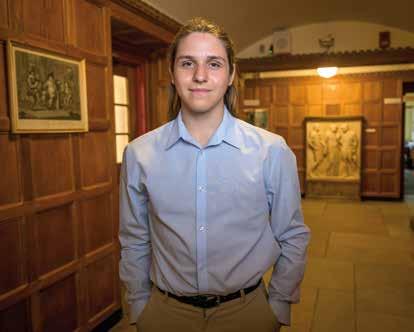
Goss, who grew up in Montana and will attend Yale in the fall, brought his middle-school curiosity about Greek mythology to St. Paul’s School, where he studied Greek for four years and Latin for three. As a Sixth Former, he earned the Oakes Greek Prize for the best examination on the writ ing of Xenophon and was elected to the Cum Laude Soci ety for academic excellence at the secondary school level, indicative of his wide-ranging academic interests.
For his capstone, Goss studied multiple aspects of Roman, Hellenic, and Indic language and culture to learn more about PIE verbal morphology and culture. For the Sanskrit part, he worked through a textbook, with input from Teacher of Classics Ryan Samuels, to learn the alphabet and some words. He also worked with Dr. Alexander Forte, lecturer in the Ancient and Medieval Studies Program at MIT, who said Goss’s questions about Indo-European morphology “demonstrated both an ex cellent command of the fundamentals and an intelligent curiosity about active areas of scholarly investigation.”
Based on the similar ways Latin, Greek, and Sanskrit all conjugate verbs, Goss re constructed what the common PIE words may have been. He also examined shared cultural aspects, noting their extensive common vocabularies relating to agriculture and deities.
“It’s interesting to study be cause linguistics is all about the way we communicate,” says Goss.
“It’s really fascinating because there’s so much to learn about hu man history.”
The project was an ambitious one, says Samuels, who notes that in addition to Goss having to learn the an cient languages, the secondary literature on the subject is vast and technical.
“Finn identified a selection of representative linguis tic phenomena that allowed him to explore this mass of scholarship within manageable limits,” Samuels says, noting that Goss was independently motivated. Aside from helping with the bibliography, Samuels says his role was merely to point him in the right direction.
“It’s unusual for students to arrive at university ready to read Latin and Greek at a high undergraduate level, but [Finn’s] foundation in historical and comparative linguistics will set him apart even within that already rarefied group.”
As for what he’ll do at the next level, Goss is keeping his options open. He loves learn ing about math and physics just as much as he’s intrigued by classics and linguistics.
While the influence of Latin and Greek is familiar to English speakers, Sanskrit, one of the best-preserved ancient languages, is present in modern lives, too — any one who’s gone to an ashtanga or vinyasa yoga class to practice asanas and kundalini breathing, greeted some one with namaste, repeated a mantra, or sustained an om knows some Sanskrit words.
No matter what course of study Goss pursues at Yale, Samuels has a prediction.
“It’s unusual for students to arrive at university ready to read Latin and Greek at a high undergraduate level,” Samuels says, “but [Finn’s] foundation in historical and comparative linguistics will set him apart even within that already rarefied group.”
Across ancient languages, Finn Goss ’22 looks for similarities in an attempt to recreate their origins.MICHAEL SEAMANS
The 146 members of the Form of 2022 will enroll at 66 different colleges and universities in the fall. One student will delay college to pursue a professional dance career, and three more will focus on athletics in pursuit of college recruitment opportunities. Though the college admissions picture is ever-evolving, St. Paul’s School graduates continue to have a wide variety of choices.
“It continues to be a landscape that is challenging. The process can be stressful, but it doesn’t have to be,” said Tim Pratt, dean of college advising. “Our role is both to educate students and families about the current admis sions landscape and work individually with each student to identify good-fit schools they are excited about. It is rewarding work.”
As it has for the past few years, last November, the College Advis ing staff introduced a rating scale designed to help the Sixth Formers refine their college lists. The rank ing tracked relative interest in col leges on a 1-5 scale. Whereas a 1 indicated a first-choice school, a 5 denoted a school the student would not attend if admitted. The numbers in between measured varying degrees of interest.
In a January report to the SPS Board, Pratt shared that the 2021-22 cycle saw “continued rampant application growth and lower rates of admission among the most se lective colleges and universities in the country.” He noted that, 30 years ago, only five institutions in the country had admit rates below 20%. In contrast, there are now well over 50 with rates below that mark.
“In just two years,” Pratt reported, “Colgate’s appli cant pool has doubled in size to more than 21,000, while Harvard’s pool topped out at 61,220, a 52% increase (roughly 21,000 more applications) over 2020.”
“Students and families have become very conscious of cost, geography, and unique programs in their college search, and they are broadening their searches and their definitions of success in the process.”
“The goal is to ensure that students are excited about all the schools on their list,” explained Pratt. “It is really effective — this year, 56% of the form that completed the rating were admitted to a school rated a 1, while 93% were admitted to a 1 or a 2. “It might be the most effective measure of the work we are doing in helping students to identify schools that match them well across the range of selectivity.”
As has been the case over the last few years, global application numbers continued to rise during the 2021-22 admissions cycle. With most colleges and universities making standardized test submission optional through at least 2022, the policy has opened the door to a flood of additional hopefuls. And because COVID has limit ed applicants’ ability to visit some schools, the number of colleges to which each student applies is also up. For SPS Sixth Formers, the average number of applications remained steady at 9.4. Factored into that number were 37 students admitted via binding early decision programs to their top-choice school and three more who were “one and done” after applying (non-binding) early action.
Overall, SPS students submitted applications for consideration to 241 colleges and universities. The form boasts a U.S. Presidential Scholar (one of just 161 nationally) and a recipient of the Gates Scholarship (one of 300 students selected out of 37,000+ candidates). While the most popular destinations are Brown and Yale (seven students each), several students will be either the first SPS graduate to attend their college, or at least the first in many years. That includes two heading to Arizona State University and one each to Baylor Uni versity, Bocconi University in Italy, Brigham Young University–Idaho, The Culinary Institute of America, Howard University, Michigan State University, Mount Holyoke College, University of British Columbia, and St. Joseph’s University.
Pratt reported that he and his team emphasize to stu dents and families that success in the college process is not about gaining admission to the most selective school one can, but about finding a college that matches one’s academic, extracurricular, and social aims.
“Students and families have become very conscious of cost, geography, and unique programs in their college search,” Rector Kathy Giles said, “and they are broadening their searches and their definitions of success in the process.”
Noting the benchmark of 93% who gained admission to a school they defined as “matching me well and (where) I would be extremely happy,” Pratt added that “this mea sure of student enthusiasm about their next steps is most affirming of the overall success the Form of 2022 enjoyed in the college admissions process.”
The Form of 2022 successfully navigates the college admissions process.
On the morning of June 5, as “Pomp and Circumstance” accompanied the 146 members of the Form of 2022 out of the Chapel of St. Peter and St. Paul and across Graduation Lawn, the swell of emotion that rippled through the crowd was palpable.

As much as that emotion was about the milestone event unfolding under picture-perfect conditions, it also was about the anything-but-picture-perfect conditions the form had endured to reach that day.
Giles. “The list of world events while you all have been here growing up is absolutely staggering.”
“When our form was handed obstacles, we rallied together, as we always do, and found ways to push through joyfully… what a privilege we have had to grow with one another.”
“It is hard to even remember everything that has hap pened during these past four years,” noted Rector Kathy
After outlining a list that included not just COVID-19 and climate change but also gun control, the #MeToo movement, Black Lives Matter, reproductive rights, and much more, Giles concluded, “Form of 2022, you’ve been remarkable throughout the whole thing. You just kept on growing and learning. You just adjusted. Nothing could hold you back. Just being here today, with you, is huge cause for celebration.”
Also cause for celebration was the fact that Graduation
was the first in-person ceremony, with unlimited guests, to be held by Lower School Pond since 2019. Families came from as far away as the other side of the globe to participate in a weekend of events that included a traditional Baccalaureate service and Halcyon-Shattuck crew races as well as a first-of-its-kind Graduating Form Parade. Those who were unable to attend in person watched the ceremony via livestream.

In her remarks, Giles articulated her gratitude for the life of Teacher of Humanities Omar Brown, who died from a sudden illness in January, and recognized three retiring community members: Director of Counseling Lisa Eber hart, Athletic Trainer Kelly Eaton, and Teacher of Fine Arts Colin Callahan. She also spoke about the School Prayer as a beacon for how to live and how to treat others — a
concept that echoed the remarks of Baccalaureate speaker Ted Landsmark ’64.
“Perhaps the one thing that distinguishes us all as a community and a family,” Landsmark said in his address, “is a sense of purpose, a sense of mission, a sense of why it is that we are here … to lead a life that commits us to helping those who are less privileged and fortunate than we are.”
Sharing her own reflections on the journey undertaken by the Form of 2022, Student Council President Eden Wright ’22 spoke about the “perseverance, resilience, and ultimate strength of this form. When our form was handed obstacles, we rallied together, as we always do, and found ways to push through joyfully … what a privilege we have had to grow with one another.”
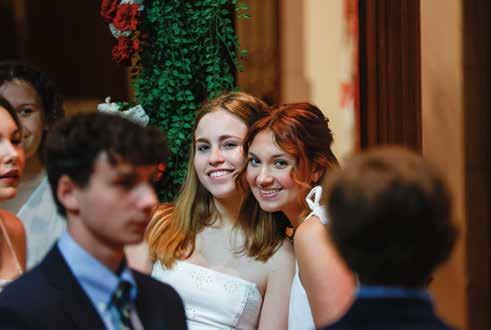


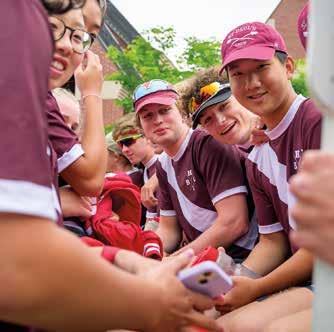
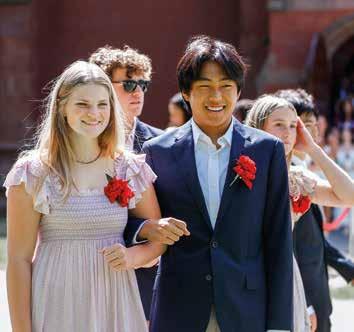
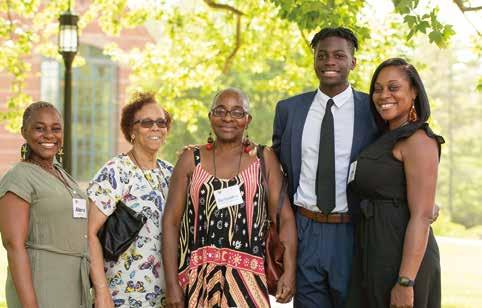


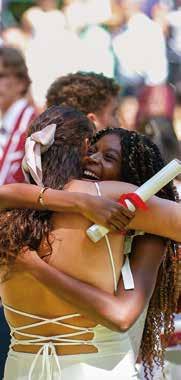




Through humor, empathy, and commitment to his students, Colin Callahan has left an indel ible mark on the SPS community in his nearly 40-year career.
If you know Colin Callahan, you know at least a few things about him. He’s funny — not just in a casual way, but deep ly, inherently funny. He’s a gifted artist, whose landscapes and still life paintings have been featured around the world. And he’s a devoted teacher — in the classrooms and studios, in the dorm, and anywhere else a stu dent or colleague needs him.
This spring, Callahan announced his retirement after nearly 40 years at the School. He and his wife, Toni King Callahan ’76, have moved to their home on the outskirts of Concord. Despite their rela tive proximity, they will be sorely missed on the grounds.
architecture, drawing, and painting. Though he arrived at St. Paul’s believing he might only stay for a year or two, he soon discovered a love of teaching.
“When I first started, my plan was to get a teaching job for a year and then apply to graduate school,” Calla han recalls. “About halfway through that year, I realized it would make no sense to give up a job like this, so I decided that’s where I wanted to stay.”
“I’ve taken his wisdom into my life and career. But it was his warmth when I was a homesick mess at 14 that I treasure. He shaped my life. I’ll forever be indebted to him.”
Callahan attended high school at The Overseas School of Rome in Italy and studied painting at Rome’s Centro Barbieri. He joined the St. Paul’s School community in 1983 after earning his B.A. in fine arts from the College of the Holy Cross and working for two years as a research analyst for a N.Y. Stock Exchange firm and one as a litur gical design consultant. He turned his talents from the stock market and art restoration to teaching art history,
By that time, Callahan had also met his future wife, Toni, who was then working in admissions and had been invited to stay on at the School to teach French and German. Since his arrival, Callah an has been an invaluable member of the SPS community. His wit and creative energy contributed to his outstanding teaching, while his knowledge of fine arts made him a critical member of the initial Third Form Humanities team. When he became director of the Art Center at Hargate (now Crumpacker Art Gallery), Callahan helped create a teaching gallery for the School that linked the work of guests artists with that of students and the SPS curricu lum. For many years, he served as the girls varsity cross country coach and girls JV crew coach and also worked as a lifeguard and swim instructor in the Athletic and Fit ness Center. For the last four years, he served as chair of the Arts Department after many years as head of the Fine Arts Program.
Callahan’s gifts carried into the residential setting, where he served as head of house for more than three
Offering thanks and commemorating what three teachers have given to the School.MICHAEL SEAMANS
decades (most of those in Conover/Twenty), shepherd ing countless students through their high school years. He also served as the School’s first director of residential life. Callahan’s impact was felt by many, including Nick Stoller ’94, who credits his mentor (along with retired faculty member Terry Wardrop ’73) for keeping him at St. Paul’s “through emotional support, warmth, and, par ticularly in Mr. Callahan’s case, humor.” Callahan served as a faculty adviser to Stoller when he started the satire magazine Spaluts, and Stoller credits him with making sure he and other magazine contributors did not cross the boundaries of poor taste.
“He was a comedy beacon, always gently nudging us toward a maxim which I can only sum up as ‘the best comedy comes from kindness and truth — and some times farts,’” says Stoller, a Los Angeles-based screen writer and producer. “I’ve taken his wisdom into my life and career. But it was his warmth when I was a homesick mess at 14 that I treasure. He shaped my life. I’ll forever be indebted to him.”
Robert Quevedo ’91 also has remained in touch with his former teacher over the years. Both Colin and Toni Callahan made him feel at home during his transition to the U.S. from his home in Guatemala. Callahan, Quevedo says, also inspired him in his career. He currently serves as the vice president and dean of the School of Architecture at Universidad Francisco Marroquín in Guatemala City.
“With Colin’s Introduction to Architecture class, I got my first taste of what would later become the initial step pingstone in my professional and academic career,” Que vedo says. “He made learning about art and architecture an absolute joy. His sense of humor permeated the classroom, and I can honestly say that the experiences in his classes were fundamental in instilling in me a love for teaching.”
Callahan’s accomplishments as a faculty member and as an artist are many. He spent the 1998-99 academic year in France, painting and studying French landscapes; his beautiful creations hang in private homes and local art galleries and have appeared on the sets of two Hollywood films (Julie & Julia and Baby Mama). His 12-panel pan orama of Turkey Pond hangs in the erg room of the Ath letic and Fitness Center to inspire rowers while training, and in 2010, he painted individual 8-by-10-inch panels from the same view of Lower School Pond every day for his 365 series, which he eventually presented in a book. He also has brought many art installations to the School. Among his favorites are the trio of 180-pound (each), life-size, metallic pelicans, created by KT Taylor ’93, which are suspended over the atrium in the AFC, and the dynamic 2013 sculpture made of galvanized steel spikes that sits in front of the building: “Plode” by John Bisbee.
In his retirement, Callahan will spend time with Toni, his daughters, Sarah ’05 and Bronwen ’08, and three grandchildren. A longtime resident of Conover/Twenty, he says he will miss having the “best commute to morn ing Chapel.” He also will miss the energy of the classroom
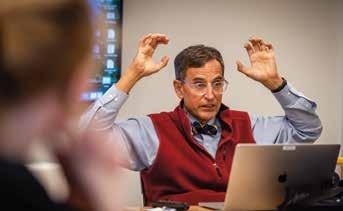


and shares that “at the end of the day, if you have a net gain in energy, things are going well.” While his contri butions will remain in the students whose lives he has impacted and in the art he has inspired on the grounds, Callahan’s typical humor comes out when asked about what he is leaving behind. He shares a story of the School putting twin granite boulders in front of the Crumpacker Gallery to help shield the copper on the building from snowplows.
“They left two slabs of granite that make no sense,” Callahan says. “I took stencils and on one of them wrote, ‘this is not art’ and on the other one wrote, ‘this is.’ They are still there. I love that this is the kind of community where I am allowed to do this. I have always enjoyed find ing the humor in the seriousness.”
In a 33-year career as an athletic trainer, Eaton helped countless student-athletes get back into competition.
JANA F. BROWNAs a three-sport athlete in Barnstable, Massachusetts, Kelly Eaton knew she loved being around athletics and athletes. Visits to the athletic trainer at Barnstable High School to treat a sprained ankle piqued her interest in sports medicine.
“I thought it would be perfect [as a career] because I love sports,” Eaton recalls.
She pursued her education as a certified athletic train er with that thought in mind. As a senior at the Universi ty of New Hampshire, Eaton was offered an internship at Governor’s Academy in Byfield, Massachusetts. Her eight years there ended up being the first stop in a 33-year career as an independent school athletic trainer. Before arriving at St. Paul’s School, Eaton served for another eight years as an athletic trainer, assistant to the director of athletics, and dorm associate at Holderness School. She has been one of the faces of athletics at SPS since her arrival in the fall of 2005. Earlier this year, she announced her retire ment after 17 years in Millville.
“Once I got the job here, it was clear to me that this would be my last job as an athletic trainer,” says Eaton, who holds an M.Ed. in sports medicine from Springfield College, where she earned the Provost’s Award for aca demic achievement. “At SPS, I would be working with another athletic trainer, a nursing staff that operated a health center 24/7, and a full-time medical doctor on campus. It doesn’t get any better.”
Over the years, Eaton has treated thousands of stu dent-athletes alongside fellow SPS athletic trainer Bob Oziomek. She also has enjoyed the other aspects of life as a member of a boarding school faculty, especially
the opportunity to serve as an adviser. Her nearly two decades at St. Paul’s have included a stint as head of house in Wing and stops in Kittredge III, Brewster, Manville, and Warren.
“Ms. Eaton was one of my most supportive faculty members throughout my time at SPS,” Chapin Bassi ’17 says. “Whether it was academics, athletics, or social life, Ms. Eaton was active in her care for my success. She nev er missed an important moment.”
During the 2019-20 academic year, Eaton was granted a sabbatical. Her plan for the year was to catch up with her family on Cape Cod and visit the other Eight Schools (Choate, Deerfield, Hotchkiss, Lawrenceville, Northfield Mount Hermon, Phillips Andover, and Phillips Exeter) to conduct research on repetitive-strain injuries in high school athletes. Her mother’s illness and the onset of the COVID-19 pandemic prevented her from in-person vis its, but she conducted Zoom interviews with the athletic training staffs at those institutions to share knowledge and identify best practices.

Much of what athletic trainers do happens behind the scenes. While the most visible part of Eaton’s job was to care for athletes during practices and games — includ ing keeping them calm while assessing on-field injuries — she and Oziomek have spent thousands of hours ar ranging follow-up doctor visits to Concord Orthopedics, transporting the injured to twice-weekly ortho clinics, and helping them navigate the road back to competition. Documentation of injuries and treatment also took up a great deal of time, along with updating parents on the sta tus of injured athletes.
Her efforts have not gone unnoticed. During Gradua tion Weekend, Eaton ran into the brother of a member of the Form of 2022. Though she had not seen him since his own graduation in 2013, he thanked her for the care and concern she provided after he suffered a serious injury as an SPS student.
“His parents were there, and they were just so thankful that I took such good care of their son while they weren’t here,” Eaton says. “I felt so touched that he remembered, and that he went out of his way to just come back and say, ‘Look, I’m all healed, and thank you so much for ev erything you did.’ The best part is watching someone get better and then actually get back out on the field and have success. That’s why we do this, right?”
Eaton’s immediate plans are to return to Cape Cod to be closer to her family and friends. She will assess what her future holds. She may volunteer with the Special Olympics, something she has done in the past, or pursue a new path. Though she is ready to say goodbye to her profession of three-plus decades, she will miss her colleagues (partic ularly Oziomek, who hired her 17 years ago), the beauty of the SPS campus, and the students who have shaped her experience as a boarding school faculty member.
When asked how she would like to be remembered for her SPS tenure, Eaton’s reply is simple: “That she cared.”
In his 25 years on the faculty, Heitmiller has made a greater impact than he ever realized.
When Scott Heitmiller returned to St. Paul’s School in the fall of 1997, he did not anticipate he would spend the next 25 years at the School. After his 1981 graduation from SPS, he never even imagined joining the faculty.
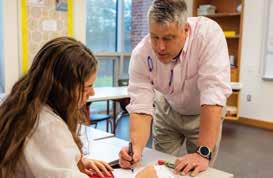
Heitmiller spent the early years of his career teach ing and coaching at Brewster Academy, Providence Day School, and The Fessenden School. His own high school mentors, including John Buxton, the late George Chase, Sr., and Cliff Gillespie, convinced him to come to Concord for an interview. Seeing them again in the place where they had made such an impression on him as a teenager was all Heitmiller needed to realize St. Paul’s would be the perfect place to teach young people and raise his own family with his wife, Diane (the director of advancement at SPS). Daughters Caroline ’10 and Elle ’12 and son Kyle ’15 consider St. Paul’s School their home.
“What [Buxton, Chase, and Gillespie] were to me was something I wanted to be for other kids,” Heitmiller says. “I felt it important to have a role model in your life, someone who was strong and expected a lot of you and brought out the best in you. They had a huge impact on me and formu lated who I am and what I am, so I just wanted to get back and do the same.”
In his 25 years on the faculty, Heitmiller has served in many roles, all of which have taught him lessons that he has passed along to the countless students he has shep herded. He has impacted students as a math teacher; as a coach in wrestling (where he was the 2012 New England Wrestling Coach of the Year), soccer, and lacrosse; as an associate dean of students; and as an athletic director. He even spent two years early in his SPS career as director of planned giving.
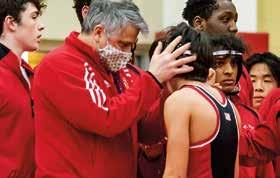
“We learn more life lessons in athletics than we do in the classroom,” he says, “and so for me it was very import ant to impart on the coaches that we are teaching as much as we are coaching, about how we act as people, how we deal with adversity. How you act as a winner is just as important as how you act as a loser, so those things are
teachable moments; they’re raw and they’re real, unlike in the classroom, where everything is very safe.”
Heitmiller also has had an influential presence in the dorm and as an adviser. In 2007, the grateful de Sa family established an advising award in his honor after Heitmiller spent four years guiding their son. Today, that annual award is given to faculty members who, like Heitmiller, “excel in their role as advisers, mentors, and/or coaches to students.”
For many years, Heitmiller has served on the Disci plinary Committee. Though the job of disciplinarian can be difficult, he has always believed in helping young people learn and grow from their mistakes. He maintains the same philosophy in the athletic arena and in the classroom.

“I went into the Dean of Students Office because I almost felt like that was my real calling,” Heitmiller says. “There’s no better way to learn and grow as a person than mak ing mistakes, and the dean’s office is all about kids mak ing mistakes. I embraced the opportunity to work with students who made poor decisions but could learn from them. I think the challenge is trying to get the students to understand that you still care about them, that you’re just being hard on them because you care, and our job is to hold you accountable.”
As a surprise for Christmas, Heitmiller’s daughter, Caro line, who returned to SPS as a member of the math faculty in 2019, contacted dozens of his former students and put together a book of their memories and well wishes. Heit miller was quite humbled by the gift and by the comments that came in from all over the world. One former student wrote: “You were and still very much are a great role mod el, coach, teacher, father figure, and mentor. You embody the type of man I want to be in all facets of life.” Another shared: “To this day, you are the first person who comes to mind when I think of the role models I have had in my life.”
In honor of his own mentors, who called him back to St. Paul’s 25 years ago, Heitmiller continues to serve as a compassionate presence for current and former students, and it is his joy to do so. He only recently took his first sabbatical after more than 30 years of teaching.
“I hope I have the same impact that my mentors had on me,” he says. “I hope that I, in some way, have a part in their character, their integrity, their work habits, their kindness, all those things. I want them to be good people and look back one day and not forget about good old Mr. Heitmiller.”
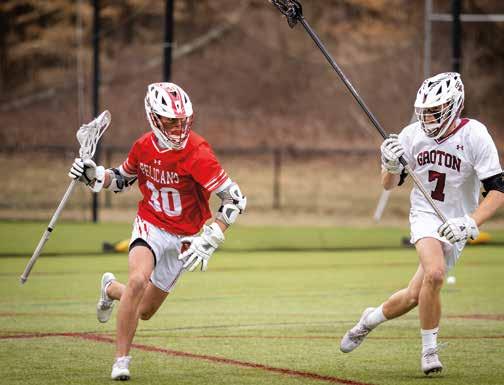

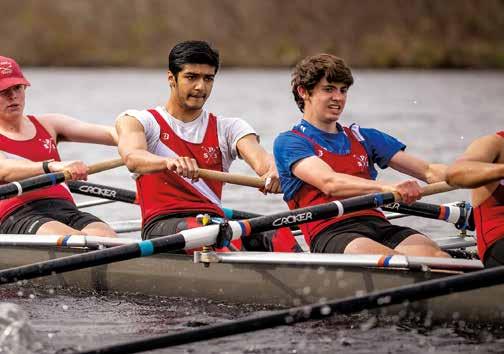

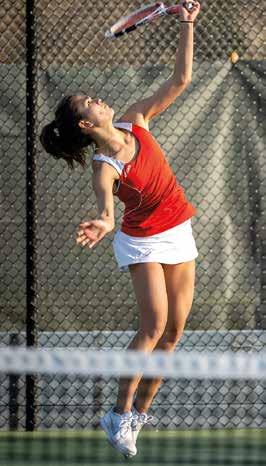

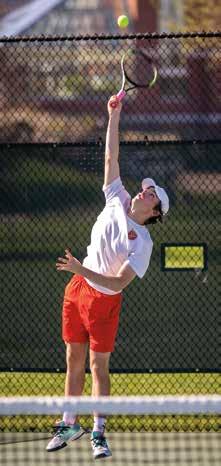



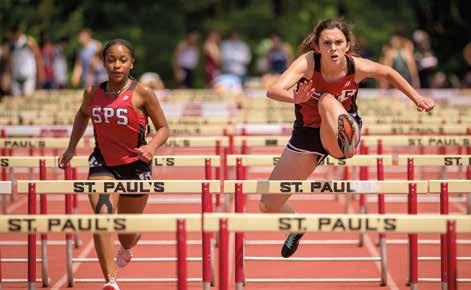
Being able to celebrate the large events that have happened in our lives since leaving SPS was a really heartwarming experience.
”
From celebrations of 50 years of coeducation and 150 years of rowing to the annual Parade, and many other gatherings, alumni joyfully returned to the School together for the first time since 2019.
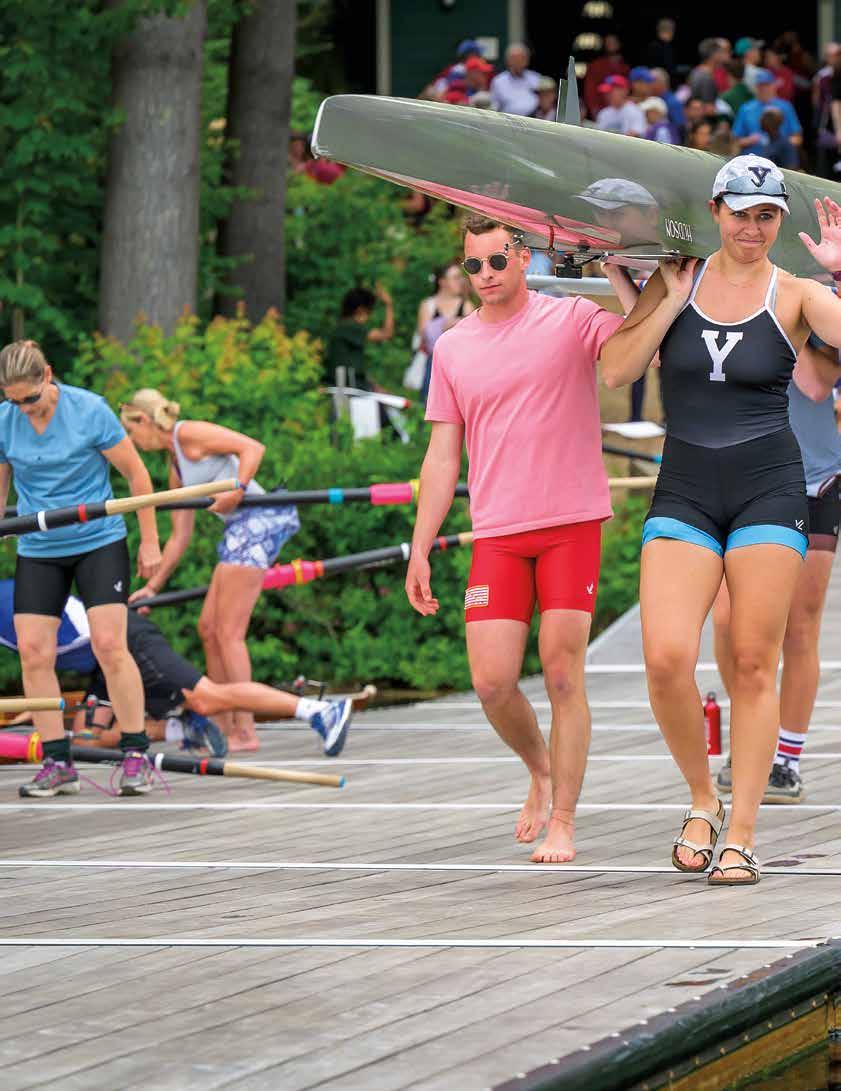 Edited by Jana F. Brown | PHOTOS: Karen Bobotas, Charlene Graham, Michael Seamans
Edited by Jana F. Brown | PHOTOS: Karen Bobotas, Charlene Graham, Michael Seamans



After a two-year hiatus due to the COVID-19 pandemic, Anniversary Weekend made a triumphant return to the grounds of St. Paul’s School. Nearly 1,100 alumni and guests were in attendance for the weekend of June 10-12. They attended the Alumni Parade (led by Judge Louis Stanton ’45, the most senior alumnus to attend), Boat Races, Alumni Chapel Service, a tribute to 150 years of SPS rowing, luncheons, dinners, and the culminating celebration of 50 years of coeducation at the School. Here are their stories.
Many thanks to the contributors to this article: Truman Bidwell ’52, Bill de Haven ’57, Tar Roberts ’62, John Landes ’67, Bob Shepley ’72, Jim Tung ’77, Lou Adreani ’82, LaMar Bunts ’87, Trevor Patzer ’92, Caitlin Riley ’96, Bradford Aston ’97, Sarah Bates Johnson ’02, Peter Harrison ’07, Kate Borst ’12, and Doug Robbins ’17.
Rekindling old bonds and reflecting on treasured mem ories was a theme of the Form of 1952’s June reunion in Concord, according to Form Director Truman Bidwell.
“What stands out in our form gatherings,” Bidwell noted, “is the chance to share memories and reestablish friendships.”
The members of the form who returned to St. Paul’s School to celebrate their 70th Anniversary Weekend were Bidwell (and Ludmila); Tom Charlton (and son Tom); Fred Hoppin; Ala Reid (widow of Breezy Reid); Stan Rinehart (and Carolyn), David Sinkler (and Becky), and Peter Wells (and Karin). Attendees enjoyed the tradition al events of the weekend, including rowing on Turkey Pond. Olympian Charlton shared stories of his 1956 vic tory in Melbourne and revealed that his gold medal will soon be on display at the Crumpacker Boathouse. At the Athletic and Fitness Center, home to a 150-year SPS crew display, the School dedicated the “Form of 1952” shell, the newest addition to the storied fleet. Appropriately enough, the water with which the boat was christened came from Long Pond, as the form was one of the last to row at that location prior to the program’s move to Turkey Pond.
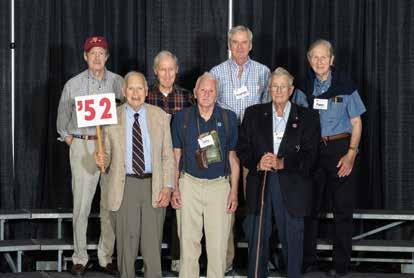
“The School seems to be in great shape and doing a great job,” Bidwell wrote. “Reminiscing about the weekend and all the fun we had made the long ride home seem short.”
Meanwhile, all events brought back happy memories for the Form of 1957, reported Form Director Bill de Haven, as 13 formmates returned to Concord to celebrate the group’s 65th anniversary.


The festivities began in York Harbor, Maine, on June 8 and 9 with a gathering at the York Harbor Inn. Jackie and David Hunt arranged dinners at the inn and at the Dock side Restaurant, while George de Man organized a pri vate visit to the former home and art studio of Winslow Homer and the Portland Museum of Art.
Following that event, Caroline and Bob Knott host ed a lunch at The Cumberland Club. Once in Concord, attendees took part in the traditional events on campus, and especially enjoyed the Alumni Chapel Service on June 11, featuring an “outstanding soprano who did a magnificent job on ‘O Pray for the Peace.’”
Tar Roberts reported that he and his formmates — 21 strong plus 10 spouses of the Form of 1962 — also en joyed the Alumni Chapel Service, including “all the old hymns and prayers, and a great sermon by Art Tung ’71.” Eight form members attended pre-reunion festivities in Kennebunkport, Maine, before the whole group met up on the grounds on June 10 for a dinner at the Upper with members of the Form of 1961, in town to celebrate their
pandemic-postponed 60th reunion. Ed Tiffany ’61 invit ed two oarsmen from 1962 to row in a boat launched on Turkey Pond the following day.
Throughout the weekend, 29 departed classmates were remembered, including Ellerbe Cole, whose bench on campus was visited by many. Those who were unable to attend Anniversary Weekend received biographies from 24 of those who returned to Concord as a way to help them feel connected to the group.
Hailing from locations all over the map, including Ar kansas (Neil Stevens) and Oregon (Dick Jaskiel and wife Carey), the Form of 1967 was 17 strong plus six spouses for its 55th. Form Director John Landes shared sever al tidbits about his formmates, among them that Will Dick and the late Dev McLean were elementary school friends; Stevens possesses an incredible memory of his days at the School; Steve Barker was a dean at Sidwell Friends School in Washington, D.C., when Malia and
Sasha Obama were students there; and Laura and Tom Beale met a stranger on a deserted Bahamas island who told them Dave Rea was the best teacher he ever had.
Faculty emeritus George Carlisle joined the 1967 al ums for dinner on Saturday, while Board President Ar chie Cox ’58 visited with the form on both Friday and Saturday nights.

“Mr. Carlisle said we were a form that changed things,” Landes shared, “that we were there at the beginning of great change.”
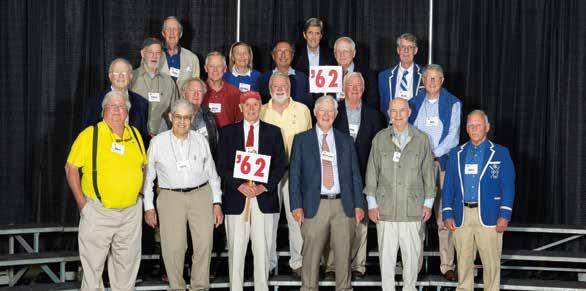
Former students, athletes, and others gathered to celebrate the life of longtime faculty member and Interim Rector Clifford J. Gillespie, Jr.
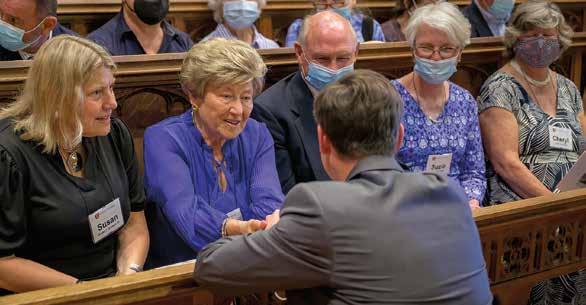 KRISTIN DUISBERG
KRISTIN DUISBERG
With plenty of laughter and a few tears, Dede Gillespie Moubayed ’79 and Susie Gillespie ’81 shared reflections of their father, former long time St. Paul’s School faculty member, coach, and Interim Rector Clifford J. Gillespie, Jr., during a service of remem brance held at the start of Anniversary Weekend.
“Our family has always been much bigger than us four Gillespies,” the sisters shared.
Mourners gathered in the Chapel of St. Peter and St. Paul to honor the man known as The Rock, who served the SPS community for more than three decades before his retirement in 1997. Gillespie died in February 2021 after a long struggle with Alzheimer’s disease. Stories of the science teacher and boys lacrosse coach, who was as known for his crew cut and red pickup truck as he was for his intense work ethic, spilled over into a reception at the Friedman Community Center. There, a steady stream of former students and athletes stood to speak about the role he had played in shaping their lives.
“He was an incredible coach, but a better man and role model,” said one.
The SPS expansion of the Gillespie family got underway in 1964, when Cliff accepted a position in the Science De partment and moved to Millville with his wife, Alina, and then-preschool-aged Susie and Dede. During his 33-year tenure at the School, he served as a science teacher, chair of the Science Department, dean of students, and Interim
Rector. An instrumental figure in the development of the School’s current science curriculum, he also helped envision the Lindsay Center for Mathematics and Science and, for many summers, taught organic chemistry for the Advanced Studies Program.
Gillespie perhaps left his greatest impression on the School as a lacrosse coach. Between 1980 and 1982, his teams enjoyed three undefeated seasons, a stretch that led to five consecutive league championships. He was known for the strict training regimen he developed for his players, which included running “The Loop” — a course through the woods around the School that, during the memorial service, Susie Gillespie recalled that she ran — once. “And then I realized he expected me to run it the next day, and the day after that,” she said, to the knowing chuckles of many of those in attendance.
In addition to Gillespie’s daughters, the service included remarks by Bruce Chan ’74, Lou Adreani ’82, and Rufus Clark ’82, onetime students of Gillespie’s that his daughters described as “the sons of Cliff” and among “the brothers we never had.” A homily was delivered by the Rev. Russell Ingersoll, who referenced his “Cliff notes” as he explained the Latin origins of the word celebration in the context of the day’s service.
“It comes from celebrare, which means to assemble to honor,” he explained. “And if this gathering isn’t a celebration according to that definition, then I don’t know what is.”
A Thursday-night kickoff dinner was attended by 28 members of the 50th reunion Form of 1972 (many others joined the group in the ensuing days), as well as by dear friends Marcia and Bill Matthews ’61 and The Reverend Russ and Pat Ingersoll.
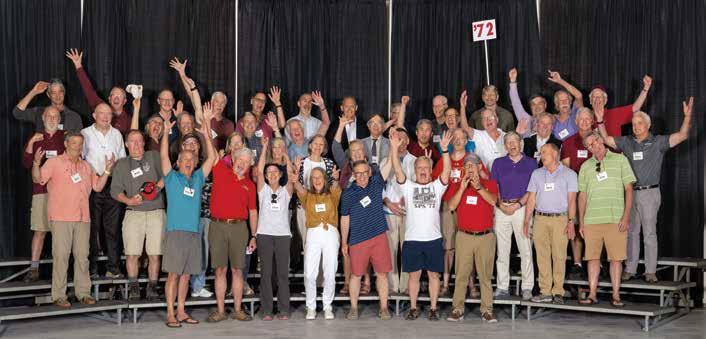
“Both Bill and Russ were terrific teachers, hockey coaches, and dorm masters,” shared Bob Shepley, who wrote about the weekend, “We were honored to have them in our lives 50 years ago, and honored to share din ner with them and their lovely wives at the beginning of our reunion.”
While a large percentage of the form returned to New Hampshire to celebrate the 50-year mark, Shepley shared that the class was “particu larly delighted that six of the incred ible, pioneering women — the first female graduates in School history — were with us.” Those six, who were among the first 19 women to matriculate at SPS in 1971, were Julia Jordan Alexander, Sally Carroll Keating, Anita Lippitt Rogers, Cindi Mann Lermond, Tori Reeve Spaulding, and Deb Sistare Holsapple
“The fellowship those 19 women formed, and then the
ensuing women the following year, was just amazing,” Lermond told Alumni Horae prior to the Alumni Parade on June 11. She was in attendance with her granddaugh ter, Angel Lermond, ASP ’16. “[I feel] a lot of happiness [being back at SPS]. These were good years. I mean, yes, there were struggles, but they were very formative and definitely shaped a lot of people’s lives.”
Other formmates came from as far away as California and as nearby as Massachusetts, and everywhere in between. Shepley credited the turnout to the diligent work and enthusiasm of organizers Keating, Charlie Bronson, and his fellow Form Director Bob Stockman. In addition to conversations into the night at the Colby Hill Inn in Henniker, New Hampshire, form members gathered on June 10 to honor deceased classmates in a service led by Bishop of Ohio Mark Hollingsworth and 1972 Sixth Form
“For this weekend, it was all about connection and feeling and joy,” Shepley wrote. “We left with excitement about our next get-together and high hopes that those who were absent this time around might join us in 2027.”
“For this weekend, it was all about connection and feeling and joy. We left with excitement about seeing one another, revisitation of memories, and deep care for each member of our class.”Front (l. to r.): Charlie Bronson, Pres Stone, Cindi Mann Lermond, Sally Carroll Keating, Mike Sweeney, Michael Rich, Lin Giralt; Row 2 (l. to r.): Mark Wain wright, Willie McDonald, Alan Frey, Deb Sistare Holsapple, Julia Jordan Alexander, Anita Lippitt Rogers, Tori Reeve Spaulding, Locke Bowman, J.T. Howell, Rick Miller, Norty Knox, Chip Haggerty; Row 3 (l. to r.): George Williams, Tom Hagerty, Tom Penhale, Jim Moorhead, John Chapin, Dawes Cooke, John Tait, Doug Chan, Henry Florsheim, Bob Shepley, Mark Hollingsworth, Bob Stockman, Henry Laughlin; Row 4 (l. to r.): John Christensen, Eric Carlson, Bayard Clarkson, Lou Borie, Ollie Wolcott, Jeff Zellers, John Kiger, Clay Prugh, David Holt, Dierk Groeneman, Tom Hewson, Ian Laird, and Howard Grace.
Back for their 45th reunion, 38 people (including form members and guests) gathered to commemorate the Form of 1977, according to Jim Tung. The long-distance award went to Alison Swift, who flew in from Arizona with her husband, Dan McKinney. Among others in attendance were Tony O’Connor, John Scheft, and Chris Smiles. Weekend highlights included an alumni crew launching on Turkey Pond — with help from representatives from the Forms of 1975, 1976, and 1978 to round out the eight plus cox swain — swimming at the dam; a lively performance by the Chonnying Mongies band; and a Saturday-night afterparty at the hotel followed by reminiscing into the wee hours.


The band, which has been playing together for three decades, featured Peter Cassels-Brown on guitar; Nick Newlin on keyboards, vocals, and accordion; Charlie King on bass guitar; and Dick Soule on harmonica. McKinney (the husband of Alison Swift), filled in on drums for Billy Schlosser, who was unable to attend.
“The enduring quality that makes ’77 special is that we are tight,” Tung shared. “Like every other form, we had our cliques and social awkwardness while in school. But now, whether we see each other every five years consis tently or less frequently, the familiarity, joy, and interest in reconnecting with everyone who returns to reunion is truly special.”
According to Form Director Lou Adreani, nearly a quar ter of the Form of 1982 returned to Millville for their 40th anniversary. Friends came from Alaska, Korea, the Unit ed Kingdom, and beyond to share in the weekend’s nos talgia. Formmates included Trish Patterson, Justin Sol omon, Rufus Clark, Chuck Doucette, Gus Wilmerding, Julie Perry Bohlen, Louisa Benton, Clo Dickey, Lucy Chubb, Clay Yonce, Ed Marchese, Katy Deanne Hamm, Mark Koumans, Gregg Lee, Chris King, Fiona Mellish, Ben Scully, James Houghton, James Hornblower, Sam Daume, Rudy Scarito, Alice Coogan Rodd, Donald Miller, and Bill Bateson. Adreani reported that Chubb, Dickey, Marchese, Koumans, and Hamm had not been to an SPS reunion in more than 30 years.
Among the notes gathered by Adreani: his daughter works at the same company as Rodd; Koumans has 1,000 direct reports in the U.S. Immigration Department; Yonce bought out all of the popsicles at a local supermarket for the Cliff Gillespie lacrosse tribute; and the COVID-sil ver-lining-induced multi-reunion-year coordination was much appreciated.
“Going forward,” Adreani wrote, “it would be great to consolidate multi-year gatherings. Everyone commented on how fortunate we all are to be a part of this institution.”
Being together in Chapel again, wandering campus, and swimming at the boat docks brought back warm mem ories for the Form of 1987, according to Form Director LaMar Bunts
About 40 formmates returned to the SPS grounds to celebrate their 35th reunion. Bunts was one of several mem bers, along with Jim Stovell, Melanie Shaw MacMillan, and Peter Elliman, who made the trip from California. Monique Washington, recently retired after two decades with the Chicago Police Department, was happy to return to the “serenity and peacefulness of the campus” and the welcoming community. Alex Brigham arrived in his trav eling van with his family, including his dog, Bear.
“He parked it on the street in front of the Upper and everyone wondered what was inside as the parade marched right past it,” Bunts wrote, “because he put a sign on the side of the van labeled ‘Bear Delivery Service.’”
Before the weekend events, Brigham and Bill Diamond
hosted a gathering at Lake Winnipesauke for a few days that featured cookouts, swimming, and bonfire conversations.
“We feel a true bond like brothers and sisters,” Bunts shared. “Because we love each other like family, it was an opportunity to reminisce and reconnect.”
Approximately 48 graduates came to Concord for a 30th reunion celebration. The biggest surprises were appearanc es by Scott Fossel from Hawaii and Francesca Carega from London. Form Director Trevor Patzer remained im pressed by the careers of so many his formmates, including Jay Truesdale, who has worked for the Department of State in Russia and Ukraine; Samantha Sparks Ekstrand, an attorney and advocate for gender equality in sports; and Blair Demers for her work in Kenya.
After attending Friday’s service in honor of the late Cliff Gillespie, the ’92s enjoyed dinner at O Steaks & Seafood, which included bonus appearances from members of the Forms of 1990 and 1991. On Saturday morning, the form


gathered for a remembrance of dearly missed classmates John Schlesinger, Sarah Devens, Jason Andris, and Chessie Drew. After memories were shared, flowers were floated on Lower School Pond in their memory.
“Our gathering every five years to remember our lost formmates is special and brings us together,” Patzer wrote.
SPS Chief Advancement Officer Scott Bohan ’94 host ed a gathering for the form on Saturday night at his home on the grounds, one final opportunity to be together after a wonderful few days of reuniting.
In contemplating why he returns, Patzer reflected: “To reconnect with friends, former teachers and the School. To recharge the old batteries with the sights, sounds, and smells of the most wonderful, beautiful school in the world.”
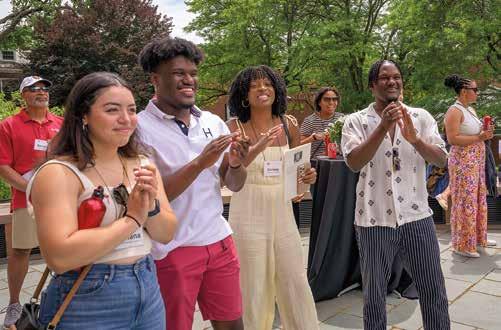

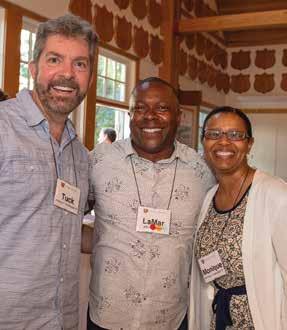

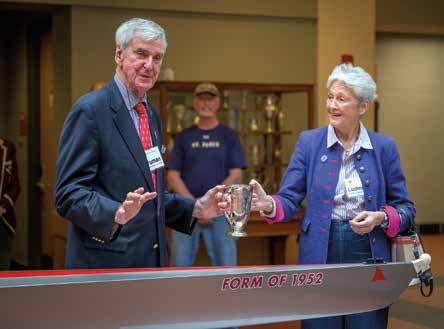

Receptions on Library Lawn and dinners in the Rectory, Crumpacker and Coit. Gatherings at Sheldon and Ohrstrom Library. A traditional Alumni Parade from the Chapel to the Hockey Center. The air of celebration at the first in-person Anniversary since 2019 was palpable all across the grounds, and perhaps nowhere more than at the Athletic and Fitness Center, where guests gathered on Friday to observe 150 years of rowing at St. Paul’s School and then again on Saturday for the culmination of the School’s yearlong series of events marking 50 years of coeducation. “Her Purpose: 50 Years of SPS Women in the World” wrapped up with a lively panel of current and former faculty members Charlene Clinton, Jane Cl unie, Theresa Ferns ’84, Zhaohong “Jenny” Li and Roberta Tenney in conversation with Rector Kathy Giles.

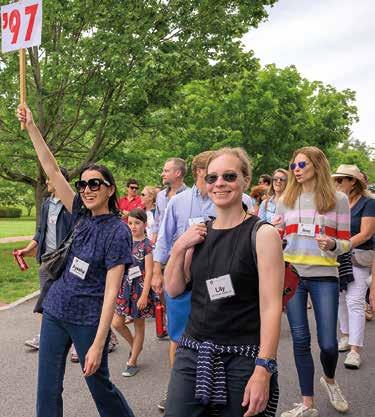


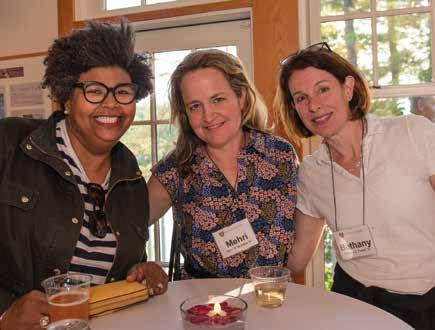

Alumni reunite to play roofball, an original SPS sport.
 JANA F. BROWN
JANA F. BROWN
“You see what the ball just did there?” asked Tony Bullock ’76. “It came off the roof in one bounce, and it fell down just an inch from the edge, under the lip. That’s the hardest thing to return.”
On the Saturday of Anniversary Weekend, Bullock was one of nearly a dozen onlookers who set up behind the parking lot to the Up per to witness a competitive match of an SPSspawned sport called “roofball.” Rematches have occurred in regular intervals between members of forms from the late 1970s through 1982 as part of reunion festivities for the last four decades. Bullock explained the rules as a group of alumni from those forms battled it out on the appointed courts (a pair of side-by-side triple-garage-door buildings) in a series of intense games.
“I would lie down on the tarmac in front of the bulldozers if the School ever tried to remove them,” said roofball veteran Biddle Duke ’81 of the beloved garages.
According to SPS lore (and Bullock), roof ball was conceived in the early 1970s as a way to have some fun after dinner and during downtime. The game involves teams of three players alternately striking a children’s play ground ball with their hands onto the roofs of the twin structures. If at any time the ball hits the ground, the team that fails to keep it in the air loses a point. Games are won when one team reaches either seven or 11 points, depending on what has been agreed upon prior to tip-off.

Bullock rattled off the names of some of the roofball legends of his time, including J.G. Treese ’76 and the late Michael Kennedy ’76. Andrew Binger ’81, who was pres ent at the June 11 game, is known by some of his own formmates as the “king of roofball.”
Members of the Form of 1981 have made rematches of the original sport a part of their five-year reunions for as long as they can re member. When they arrived at St. Paul’s as Third and Fourth Formers, the ’81s mostly watched and learned from the older students who were then spearheading the game’s bud ding tradition. Players from the Form of 1981 now represent the peak of roofball, according to Duke, and they are happy to carry the torch.
“There are a lot of great reasons to re turn to St. Paul’s for reunions,” said Duke, “but for a bunch of us in the forms around the early 1980s, the pilgrimage would be emptier without a few hours battling it out at our childhood athletic shrine behind the Upper. This wonderfully silly, intense game is unique to that place and a time in our lives. And when 50-somethings get to feel like kids again, we’re all winners.”
Alumni gathered at the Athletic and Fitness Center at 8 a.m. on Saturday for the annual 5K Fun Run through the woods on the School’s cross country course. It was a beautiful, clear morning for a run, which kicked off a full day of events in Millville.

Retiring Teacher of Fine Arts Colin Calla han and Director of Parent Engagement Jen Fithian led the way on the trails.
“The woods are my favorite part of the SPS grounds,” said Jessica McKenzie ’07, who participated in the Fun Run with her father, Cecil ’67, “so I was excited to hit the trails bright and early with my dad on a perfect morning. But after a late night catching up with formmates, I took the early turn-off to cut the run a bit short; Dad put me to shame by doing the whole 5K.”
Seeing his formmates Roger Walcott ’92 and Townsend Baldwin ’92 dashing ahead of him on the route and deciding it might be fun to pull a prank, Trevor Patzer ’92 found a shortcut that placed him ahead of the pair on the trail.
“I saw the opportunity, hid in the bushes, and jumped out at them, roaring,” shared Patzer, who added some additional “fun” to the run. “They both jumped about two feet straight into the air.”
Hijinks aside, participants enjoyed the beautiful scenery that surrounds the School and took time to reminisce about a place that helped shape their formative years.
“It feels really good to be back,” said Cath arine Morgan ’02, a faculty child who grew up on the SPS grounds. “It’s still as beautiful and as special as it ever was.”
Front (l. to r.): Barclay McFadden, Ian Cohen, Carrie Lee, Ian Cho, Aiden Cho, Suwan Cho, Carol Fwu Lee, Abby Tarbox, Patti Lin, Emily Brands, Gregory Cohen, Paige Cohen, Alana Pietragallo Bedoya, Katie Zug Volkmar, Eliah Kim, Evelyn Kim, Honey Brown, Minnow Brown, Bea Brown; Row 2 (l. to r.): Max Lamont, Terrance Edney, Antoinette Edney, Terrance Edney III, Yuri Cho, Hyun Cho, Ed Saavedra, Jose Lopez, Elizabeth Kim, Kenneth Kim, Frances Merrill, Amanda Filoso Schreyer, Jessica Hayne, Alexandra Leigh, Noelle Lee Okoth, Dan Okoth; Row 3 (l. to r.): Adrian Stafford-Browne, Angela Bediako, Sitso Bediako, Stephanie Oliver, Liliana Polo-McKenna, Veronica Ogle Ladejobi, Rick Eastland, Nick Cohen, Argo Caminis, Lloyd Walmsley, Ayesha Brantley-Gosine, Jill Smith, Isaac Ro, Nathan Brown; Row 4 (l. to r.): Ned Hall, Gus Maclaurin, Alexander Tilney, Paul Delaney, Owen Weihman, Calvin Burton, Todd Norris, Peter Light, Sean O’Sullivan, Lindsay Purrington O’Hara, Devie Deland Perry, Ben Loehnen, Caitlin Riley, Carey Wagner, Geoff Smith, and Adam Culbert.


Not to be outdone, the Form of 1996 boasted 51 attendees for its delayed 25-year reunion, according to Form Director Caitlin Riley. The form began planning a return to SPS after last year’s virtual event, when members talked about crashing 1997’s anniversary. “When we heard it would be a joint reunion, the excitement grew,” Riley reported.
The ’96s and the ’97s joined 1995 graduates downtown, where the band SNAFU, led by Nick Van Amburg ’95 and Harry Eichelberger ’95, played a set. Keith Porteous
Meade ’95 and David Walton ’97 made special appear ances, rocking to hits from Pearl Jam, Bush, and Clarence Carter. On Saturday night, the 1996 crew took over The Draft Sports Bar & Grill and laughed the night away.
“All of us were incredibly grateful to spend time with those in other forms,” Riley added. “These are people we lived with, ate with, studied with, played sports with, and spent the formative days of our youth with. Many of them we hadn’t seen in 26-27 years. I think everyone hopes the School will do this sort of joint event again.”
The 97s arrived in Millville for their 25th anniversary with excitement and positive energy, according to Form Director Brad Aston. From its Friday dinner in the Rectory hosted by Rector Kathy Giles to the memorable afterparty featuring the Form of 1995 jam band SNAFU, the weekend got off to a strong start that only picked up momentum.
Clemie Drackett Philbrick kicked off Saturday with a “runaway victory” in the 5K Fun Run, and the form’s dedicated rowers — including Catherine Ruedig Hunter, David Walton, Oliver Haslegrave, Austen Earl, Pete Pol
lock, and Monty Forman — managed to achieve several convincing wins in the Boat Races that afternoon. Saturday night featured a dinner in the Lindsay Center courtyard with the Forms of 1995 and 1996, followed by the after party at The Draft, with Cornelia Henning Van Amburg’s customized Form of 1997 Spotify dance party mix.
“As the group limped home Sunday morning,” Aston wrote, “we lamented that it may be another five years before we gather again, and fledgling plans were made for a 2023 ski weekend. All in all, an amazing weekend filled with so much history and great memories, both new and old.”
Nearly 30 members of the Form of 2002 traveled from across the country — from Seattle, San Francisco, Denver, Alabama, New York, Boston, and in between — to cele brate their 20th SPS reunion. Many of them were accom panied by family members, including spouses, children, significant others, and parents.
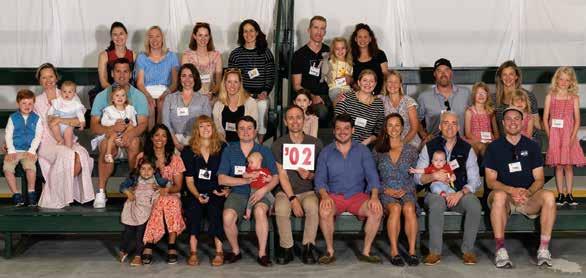
“As we paraded down Rectory Road to the Hockey Center,” Sarah Bates Johnson wrote, “it was fun to see our children play with each other and form the next gen eration of friendships.”
From singing in Chapel to shopping at the bookstore, from hanging out at the boat docks to rowing along Turkey Pond, the familiarity of being back on SPS grounds was a welcome walk down memory lane for the ’02s. At the 150 Years of Rowing Celebration on June 10, Alex Hearne
joined legendary crew coach Chip Morgan in conversa tion about rowing at SPS. Morgan’s daughter, Catharine Morgan, was enjoying time on the grounds with her form mates and also revisiting her childhood home. She noted that it had been a while since she had been back, but “it’s still as beautiful and as special as it ever was.”
Will and Ashley Dunn came to Anniversary with their infant daughter, Isla Cooper Dunn, and were thrilled to be back. “St. Paul’s was transformative for me as a stu dent, but also as a person,” said Will Dunn, who serves as president of the SPS Alumni Association. “What’s very special about this Anniversary Weekend is that it’s my 20th reunion, but it’s also my wife’s 20th reunion, and we have returned to Millville with our daughter. We met not far from here 24 years ago; it’s just amazing how St. Paul stays with you in really deep and meaningful ways.”
Meanwhile, the Form of 2007 descended on Concord with the Forms of 2006 and 2005. “That certainly changed up the dynamic of our 15-year reunion,” Form Director Peter Harrison wrote, “as did the fact that Anniversary was held one weekend after Graduation. The reunion felt a bit more relaxed as a result, yet Karl Schoch helped me reflect on how not having the graduating class bring up the back of the parade made the proces sion feel less spirited. It is indeed powerful to witness the present meet the past.”
Several of Harrison’s formmates brought their children to the reunion, which, he noted, “certainly increased our general level of cuteness this year.” Scan to watch the Anniversary video here.


 KRISTIN DUISBERG
KRISTIN DUISBERG
For some, it had been only a couple of years since they last rigged up a rowing shell, hoisted it overhead under a coxswain’s direction, and launched it at Turkey Pond in a St. Paul’s School uniform. For others, it had been decades. During the Anniversary Weekend Boat Races, held on June 11, a total of 108 alumni rowers and cox swains turned out to helm 11 eight-seat shells, a coxed four, a pair, and a double under what Trish Patterson ’82 deemed “perfect rowing conditions” — a deep blue sky striped with bright white clouds, warm temps, and just a hint of breeze ruffling the pond’s navy surface.
The format may have been different from past Anni versary races — because Graduation had taken place the weekend before Anniversary, there were no student rac es, and the Shattuck-Halcyon rivalry was, if not absent, at least muted — but there was no shortage of excitement and energy among rowers and spectators. To the ap preciative cheers of those gathered outside Crumpacker Boathouse, ranged across the bleachers and standing at the water’s edge, alumni crews rowed the length of the pond from the mile mark to the turn by the dam. A num ber of them sported their boat club shirts or SPS unis, tangible connections to their time as SPS student-athletes and to their friends and former teammates.
“The mood and the tone of the crowd was extremely positive,” head boys crew coach and Teacher of Humanities
Colin Campbell said, “and the alumni who rowed were appreciative of the opportunity to get back on the pond.”
Among them was Ned Hall ’96, a Shattuck, who went on to row at Dartmouth. “It’s probably been 20 years since I was in a boat,” he said. “Somehow, the boats don’t go as fast now as they used to.”
Patterson, a Halcyon, rowed at Rollins College and has remained involved with the sport as a master rower and coach. “It was so fun to be back out there,” she said. “I got adopted by a boat of ’95s and ’96s, and it was an awesome experience.”
One of the last boats to launch included Truman Bid well ’52, another Shattuck, who was celebrating his 70th SPS anniversary. Laughing a little to find himself in the bow, where the smallest rower typically sits — “I was never the heaviest guy,” he said, “but I don’t think I was bow material” — he noted that he’d last rowed during Anniversary in 2015 and, after all these years, still misses Long Pond, where SPS crews rowed until 1951. This year, he rowed in the Truman and Albert, a shell that he and his wife, Ludmila, donated in honor of formmate Albert Francke ’52.
“It’s the boys first boat, known around the boathouse as ‘the friendship boat,’” he explained, its final trip for the day down Turkey Pond a fitting finish to a powerful celebra tion of rowing as an enduring part of the SPS experience.
At least four dozen members of the Form of 2012 came back to celebrate their first decade as high school grad uates. Charley Biddle proved to be a trooper, traveling from Shanghai, and then arriving early for the 8:30 a.m. choir rehearsal ahead of the Saturday Alumni Chapel Service. Cheyenne Smith was unable to make it due to a conflict with her wedding day, while Form Director Kate Borst shared the news of her own pending nuptials.
“Singing in the Chapel brought back wonderful mem ories,” Borst said, “especially coupled with Rector Giles’s
touching remarks about the eternal echoes of past sounds and voices in a space.”
Weekend highlights included a group of 2012s diving off the docks at sunset. Like many of the other forms who attended Anniversary 2022, the Form of 2012 especially enjoyed the opportunity to gather at St. Paul’s with class mates from nearby forms, in this case 2011 and 2015.
“I think our form really likes each other,” Borst wrote. “It was so lovely to see that so many of us are still in touch with our close friends from our SPS days, and that everyone seems truly happy for our fellow classmates and where they are in their lives right now.”
Enthusiasm also was evident for the Form of 2017, which boasted more than half of its members for the weekend. If an award existed for best effort to return, it would have gone to Yutaro Shimamura, who flew from Tokyo and spent 36 hours on the ground before turning around and heading back to Japan. Form director Doug Robbins listed dinner conversations, dancing, and “just generally being together again” as the best parts of the event. The form also enjoyed seeing friends from the Forms of 2015 and 2016 for the first time since all three groups were students together.
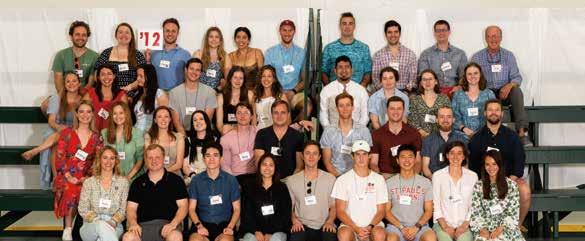
Throughout the weekend, Robbins and others revisit ed favorite spots on the grounds, including the Chapel, Crumpacker Boathouse, Moon Rock (sculpted by Jo seph Wheelwright ’66), and the carved form plaque that hangs in the Lower Dining Hall.
“We were all so happy to be with one another and have fun,” Robbins wrote. “Our form word was ‘resilience,’ which we exemplified during our time at SPS and after. Being able to celebrate the large events that have hap pened in our lives since leaving SPS was a really heart warming experience.”



The SPS BIPOC Alumni Advisory Council hosted a pair of events on June 11. The first was a BIPOC Alumni So cial held on the terrace and in the Baker Reading Room of Ohrstrom Library. Advisory Council Chair Ray Joseph ’90 greeted attendees with a few words of welcome, while Council members Caryn Cross Hawk ’76, P’09, Jose Leos ’91, and Alumni Association President Will Dunn ’02 also were in attendance. The event was a chance for alum ni to connect with one another across SPS generations. That same day, the Council welcomed alumni and guests to a DEIJ Faculty Meet and Greet. Director of Diversity, Equity, and Inclusion Initiatives Bethany Dick erson Wynder introduced attendees to the new Interfaith/ DEIJ Common Room in Sheldon. Current teachers Litz rudy Justinvil, faculty adviser to Onyx; Michelle Hung, faculty adviser to the Women of Color group; and Pankti Dalal, adviser to the Hindu Society/South Asian Society and co-chair of the Faculty DEI Council, spoke about the 2021-22 academic year. After the program, alumni and faculty engaged in one-on-one conversations.
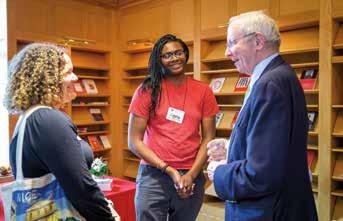
On June 10, the SPS LGBTQIA+ Alumni Advisory Council hosted a social at Ohrstrom Library. With Lower School Pond as the backdrop, the event offered an opportunity for members of the LGBTQIA+ community and their allies to connect with one another during Anniversary Weekend. Ben Loehnen ’96, who co-chairs the Advisory Council, offered a welcome and brief remarks at a recep tion also attended by Council members Dustin Brauneck ’99, John Howard ’71, and Jim Woodward ’68 as well as Alumni Association President Will Dunn ’02.
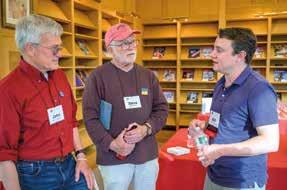

COVID-19 has exacerbated the teen mental health crisis in America. Here, alumni thought leaders weigh in on the topic.
 IAN ALDRICH
IAN ALDRICH

Is someone anxious or depressed because they’re on social media or is someone on social media because they’re anxious and depressed? These are fraught times, and young people go through cycles of being very activated and relatively passive.
”
The last decade has been a complicated one and, along with the economic jolts, a pandemic, and polarizing politics, one clear and perhaps not-so-surprising fact has emerged: the United States is contending with a mental health crisis.
According to a 2022 report issued by the nonprofit group Mental Health America (MHA), in 2019 nearly one in five Americans, some 50 million people, experienced a mental illness. Reports of suicidal ideation also contin ued to climb, a troubling trend that goes back to 2011.

The problem has been especially acute for teens and younger children. In April, the Division of Adolescent and School Health at the Centers for Disease Control (CDC) and Prevention published the results of a sur vey taken earlier in the year that polled the behaviors and experiences of 7,705 public and private high school students across the U.S. Nearly half of the respondents reported feeling regularly hopeless or sad for periods of more than two weeks during the 12-month period lead ing up to the survey. In particular, the report highlights the stresses placed on specific populations. Asian, Black and multiracial students who had experienced racism were more likely to have poor mental health outcomes than their peers who had not, according to Kathleen Ethier, who heads the CDC division. Among lesbian, gay, and bisexual teens, 47% of the respondents reported they had “seriously considered committing suicide.”
The CDC report came on the heels of a late 2021 is suance from U.S. Surgeon General Dr. Vivek Murthy, in which the nation’s top physician declared an advisory on the unprecedented stressors the pandemic had placed on younger Americans.
“Mental health challenges in children, adolescents, and young adults are real and widespread,” Murthy reported. “Even before the pandemic, an alarming number of young people struggled with feelings of helplessness, depression and thoughts of suicide — and rates have in creased over the past decade … the future well-being of our country depends on how we support and invest in the next generation.”

Just how we do that is a matter of profound importance. For a better understanding of what’s brought us to this moment and what can be done to create healthier communities for kids and young adults, we turned to four alumni thought leaders with extensive backgrounds in the mental health space: Dr. Michael Rich ’72, Dr. John Potter ’85, Dr. Ann Abraham ’86, and school counselor Sara Imbriglia Leone ’94.

While the increase in depression and anxiety can’t be ex plained by one single driver, experts do say it’s impossi ble to ignore the impact digital life has had on America’s youth. A recent report issued by Common Sense Media states that Americans between 13 and 18 years old spend an average of nine hours a day using entertainment me dia, such as gaming and social platforms. The result, says Potter, a board-certified behavior analyst and a school psychologist in the Exeter, New Hampshire, school sys tem, can be an information overload.
“Generally speaking, the amount of input they’re getting, whether it be from social media or the 24/7 news is constant and can sometimes be unre lenting,” says Potter, who has worked in education for 31 years, including the last 22 in public schools. “But it’s the same brain kids had in the early 1900s when the worries were a lot different. Now those brains are managing all this additional input and that can be over whelming, which can lead to stress and possibly evolve into anxiety.”

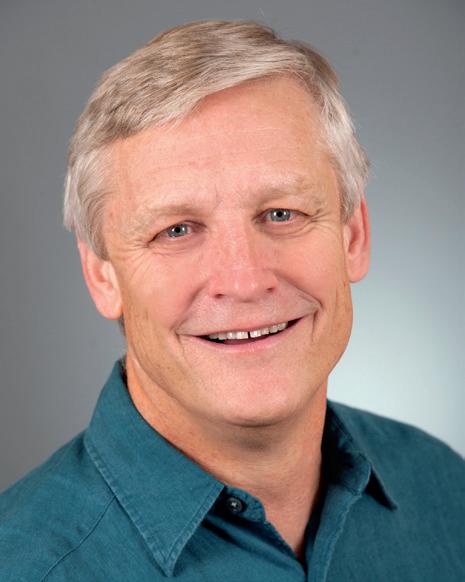

Rich, an associate professor of pedi atrics at Harvard Medical School who practices adolescent medicine at Bos ton Children’s Hospital, agrees. He is one of the world’s foremost experts on the impacts of digital technology on the health and development of teens and younger children. Known as “The Mediatrician,” he is the director of Harvard’s Digital Wellness Lab and founding director of the first evidencebased medical program addressing physical, mental, and social health issues associated with technology. He says that while many digital platforms have had a revolutionary effect on communications and efficiencies, their prevalence has exacted a profound cost on the kind of relationships we form.
“The digital ecosystem amplifies what we say and has eroded our deep and meaningful and sustaining con nectedness with each other,” he says. “You’ll see kids all sitting around star ing at their own smartphones instead of hanging out and talking to each other. It feels both distant and anonymous. It encourages young people — all of us, actually — to feel less liable for what we say and do. It creates this underlying anxiety to want to be seen and heard. And how do you come out of the mosh pit of information if you’re not edgy, if you’re not trolling in some way, or if you’re not saying something provocative?”
Rich comes at the work from a distinct perspective. Prior to becoming a doctor, he forged a career in film as a screenwriter. His understanding of narrative and ability to consider multiple points of view greatly impacted his career in medicine. In the early 1990s, he began work ing with kids with chronic diseases by handing them camcorders so they could document how their illnesses affected their lives. “Instead of looking from the outside in,” he says, “I wanted these kids to teach me what their experience was like from the inside out.”
His is a more nuanced embrace of medicine and, as such, Rich steers clear of black-andwhite prognostications to explain the problems today’s teens face. Strictly laying blame for the rise in anxiety and depression among young Amer icans on devices or tech, for example, without further scrutinizing the envi ronment in which they are used, fails to get at the real problems, he says.
“Is someone anxious or depressed because they’re on social media or is someone on social media because they’re anxious and depressed?” asks Rich. “These are fraught times, and young people go through cycles of be ing very activated and relatively passive. We were very ac tivated in the late sixties around Vietnam, feminism, and racism. And I think this generation has also become acti vated. Unfortunately, what’s happened is they’ve also be come more divided. There isn’t the same kind of unity that maybe existed before. They’re being forced to pick sides.”
Potter says COVID-19’s impact on schools and its stu dents has been multi-layered: Not only did the pandemic isolate kids from their peers for a long stretch of time, but that isolation also frayed students’ abilities to navi gate large public settings laden with complex social in teraction, rules, and expectations. And that has ratcheted up behavioral issues, social interaction, and problems around aggression that counselors like Potter encounter in young people.
“Kids were out of the structured [public] school sys tem for two years,” Potter says. “And while I think it be came stressful and isolating for a number of kids, I also think many kids fell out of practice of what it’s like to be in school and to get up early and go to several classes a day, suddenly interact with a wide range of kids, and lis ten to teachers tell them what to do. This return has been challenging and stressful for many and led to some stum bles. I think there was a thought that everything would be back in place by now but really this is going to be a two- or three-year process. It’s going to take some time to build back skills and endurance.”
That’s not to suggest public school systems like the one Potter works in haven’t been attuned to what their kids have experienced and are experiencing. Out of this global health crisis, he says, has emerged both a greater cultural acceptance of the issues around mental health and larg er focus to do something about those issues. In Exeter, a local grant has given students the chance to meet with a mental health clinician to screen during their annual physical.
“I think it’s fantastic,” Potter says. “Normalizing a mental health screening alongside a yearly physical can go a long way in decreasing stigma and helping students get early ac cess to the help they may need. A resource like this helps kids and parents manage an increasingly complex world.”
Sara Imbriglia Leone ’94, who served on the SPS faculty from 1998 to 2000, agrees that the con cerns around COVID-19 have ushered in new ways of thinking and approaches to helping kids receive better mental health support. A middle school counselor at Winchester Thurston, a pre-K-12 indepen dent school in Pittsburgh, Leone says that in the last year, especially, schools like hers have poured more resources into working with kids on their anxiety and depression.
“In our school, we’ve expanded our counseling team,” says Leone, who holds master’s degrees in counseling psychology and school leadership. “We went from one part-time person to three full-time people. We’re also be ing very deliberate about how we incorporate social and emotional well-being lessons into our school culture. We want to organically create an environment that is thoughtful about how teenagers are doing and feeling.”
Like others, Leone has had a front-row seat to the im pact social media has had on her students’ lives, and the contrasts it creates with her own experience at St. Paul’s are impossible to miss.
“Kids today are much more aware of what’s going on and much more aware of what they are not a part of,” says Leone. “When I was growing up, if kids got together and they weren’t included in something, life moved on and they’d be okay. But one of the conversations I have fre quently with our kids today revolves around this feeling of being excluded because they see what’s happening on social media and what they’re not a part of. When they’re not a part of something, it’s hurtful. And it’s right there in their face, right at their fingertips, and that’s something people in my generation never had to go through.”

“One of the ways the schools can be really helpful is making sure kids have one adult in their school community they can talk to when they feel like that pressure is too much.”
Experts also are careful to point out that the status of young adult mental health can’t be divorced from the anxieties that emanate from the news and the sometimes-apocalyptic headlines that accompany it, which shape not only how young Americans feel about the current state of the world but how they feel about their own future.

Dr. Ann Abraham, a specialist in stress and its effects on the brain who has practiced family medicine for nearly three decades, has witnessed much of this. Beginning at a young age, she says, kids absorb the stresses and anxieties around them, be it from teachers, parents, or other adults in their lives. While working in Texas several years ago, Abraham encountered one five-year-old boy who was exhibiting high levels of stress. The cause? He was wor ried about whether his school would score well enough on a state-administered test that determined the level of federal funding the institution received.
“How does a five-year-old get that sense?” says Abra ham, who now shares her expertise around the country as a traveling physician. “They hear things, they feel things — they’re extremely empathetic — and then they bring that stress onto themselves. But it’s also hard to keep kids away from this stuff because so much is coming at them.”
That includes a host of external pressures, notes Leone. Young people feel like they have to excel academically, they have to find success in sports, they must play an instrument, have lots of friends, and they have to look good on social media.
“There all these different pres sures they place on themselves from all these different parts of their lives,” Leone says. “One of the ways the schools can be really helpful is making sure kids have one adult in their school community they can talk to when they feel like that pres sure is too much. It doesn’t have to be a school counselor. It could be their soccer coach. It could be their history teacher. It could be another administrator. But when they are feeling like that pres sure has gotten to be too much, it is critical that they have an adult they can talk to.”
of the pandemic for many kids that previous generations didn’t develop until much later in life.
“I think a lot of kids have learned how to deal with stress and deal with situations that are totally out of their control,” she says, “probably at a younger age than many of us did a couple generations ago.”
Abraham, meanwhile, points to the rising acceptance of mindfulness in different public settings, including school cultures, as a positive development. She says the more stu dents can find the time to slow their thinking, even for just a few minutes a day, the greater the chance they’ll be able to manage moments of real stress and anxiety.
“It doesn’t mean meditating and it doesn’t mean yoga,” she says. “It means finding something that you truly en joy, that you’re so engaged in that you lose sense of time. That is your mindfulness. So maybe for one person it’s artwork, for someone else it’s basketball, and for others it might be yoga or rock climbing. The key is finding some thing that stops the thinking about things and gets you so absorbed by the experience of doing that one thing.”
That means creating spaces for teens to feel the free dom to make those connections with other parts of their lives. It also, says Rich, means fostering greater connec tions between adults and children.
“We need to start listening to kids and start really hearing what they’re experiencing and what their per ceptions are,” he says. “One of the biggest underlying contributors to anxiety and depression is the feeling of helplessness; kids don’t feel they have a voice or power to create change. They don’t feel like they have the power to make choic es in the family environment or the classroom environment.”
“I think a lot of kids have learned how to deal with stress and deal with situations that are totally out of their control, probably at a younger age than many of us did a couple generations ago.”
One of the best things a parent can do to dislodge their child from, say, a video game that has become a coping mechanism for stress or anxiety, Rich advises, is to try to un derstand the environment that has drawn their child there in the first place. And the best way to do that is to play the game with them.
Many schools, public and private, including St. Paul’s and Winchester Thurston, where Leone works, are making sure that happens. That’s one of the reasons why, despite the current challenges, the experts included in this story remain resolute about their hope for a better future. Leone, for example, believes that a resilience has emerged out
“You’re now entering their world as a student and try ing to learn from them,” he says. “Not as a parent who’s wagging their finger and saying, ‘I hate this thing, turn it off.’ You’re saying to them, ‘I want to understand this.’ You’re also making yourself open and vulnerable because they’re gonna clean your clock. Now you’re coming from a completely different place when you talk about the game and why they play it. New channels of communica tion are opened — and that can make a big difference.”
Brett Forrest ’91 began covering Ukraine 20 years ago as a freelance reporter for Fortune magazine. He has come to love the country and the city of Kyiv, where he lived for a time and has forged many close friendships. Recently, Forrest provided on-the-ground coverage of the Russian invasion of Ukraine for The Wall Street Journal, where he is a staff reporter. When Russia began building up forces on the Ukrainian border, Forrest volunteered to travel to Ukraine to cover the emerging conflict.

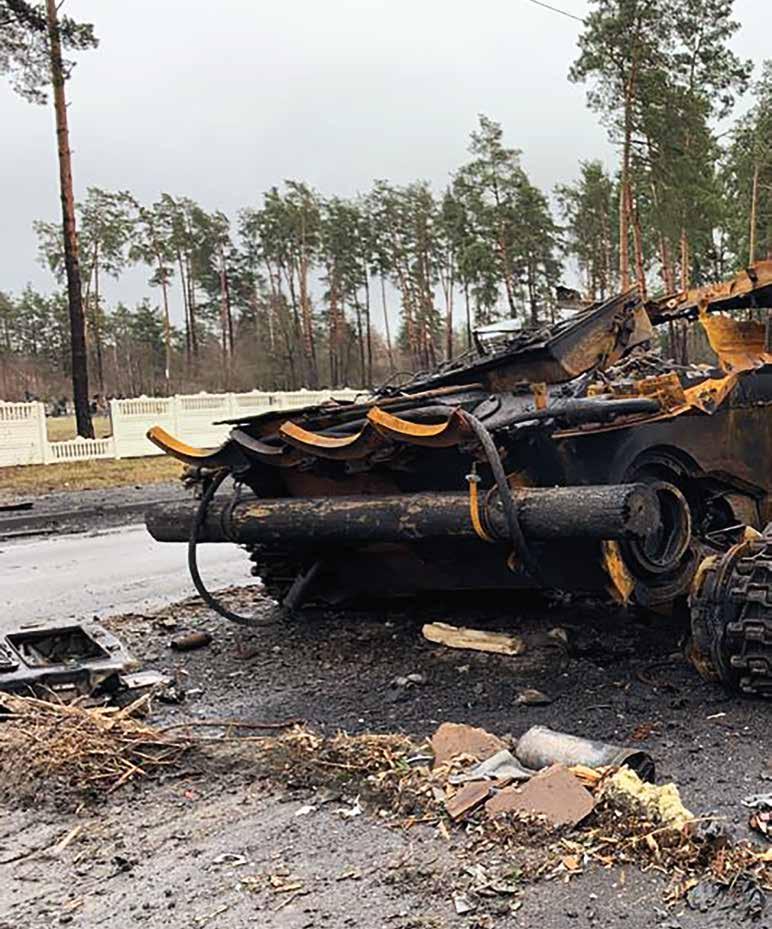
In the midst of the Russian invasion of Ukraine, journalist BRETT FORREST ’91 found himself on the front lines of the conflict.

Forrest spoke with Alumni Horae Editor Jana Brown about his experience covering the conflict in Ukraine.
What was your first introduction to Ukraine?
In 2002, I visited for a wedding. An American friend of mine was marrying a Ukrainian woman. It was my first experience in Ukraine, and I really loved the place.
I was living at the time in Russia and the flight from Mos cow to Kyiv was about an hour, so I spent a lot of time in Ukraine and I started reporting there. The first reporting I did was the following year, the Orange Revolution. I got my first taste of Ukrainian politics, power, and business, how it all worked at the top levels there.
Can you describe what Kyiv was like before the invasion? Kyiv is a fabulous city. I always told people Kyiv was sort of ‘Mos cow light.’ By that I meant it kind of plays by the same rules, but it’s a much easier lifestyle. Moscow is aggressive, hard-hitting. It’s a place of go-getters and ambition. Kyiv has some of that, but its people are generally much friendlier. Over the last number of years, it has really developed an interesting sort of restaurant/café scene. The younger people are very much connected to the rest of the world. There’s a great emphasis on being active and not being tied up with work all the time. It’s a great life, especially in the warmer months, outside of the city, along waterways, barbecuing, drinks — all that stuff that really rounds out a life.
on one of the main streets in the middle of a workday and hear yourself think.
It was eerie because, on one hand, you’re thinking this is quite an interesting sensation to be in this city that I know so well under these unique conditions. But, on the other hand, you’re thinking maybe they’re all right. I’m still here and is Russia going to invade? And am I going to be stuck in the middle of it? If so, what is that going to look like? And what kind of danger are we in? But as a reporter, that’s where you want to be.
Of course this was your job and you were going to do it, but were you afraid at all?
“I’m still here and is Russia going to invade? And am I going to be stuck in the middle of it? If so, what is that going to look like? And what kind of danger are we in? But as a reporter, that’s where you want to be.”
It was something I have never felt before; it was more of a forebod ing. I was staying at the Hyatt in the historical center, right next to Saint Sophia Cathedral in the heart of Kyiv. When it started that early morning, I was awoken by a phone call from our security guy. And then I heard the explosions of the first bombs that were falling, and they sounded pretty close. It was total chaos and also just dealing with the realization that Putin had actually decided to do this reckless thing. My colleagues and I were trying to piece together everything so we could tell people what was happening.
How long were you there before you actually got to a safer point?
What did you observe during the initial days of the invasion?
The answer probably begins in the weeks leading up to it, because the United States was releasing its assessment of Russian intentions. Before the invasion, the United States was saying we believe that Vladimir Putin intends to invade Ukraine. That assessment was severely affect ing the Ukrainian economy. All investments into the country pretty much stopped and people slowly started leaving. The Ukrainian government and businesspeople were up in arms, asking, ‘Why are you telling everybody there’s going to be a war?’ But the longer this went on, the greater the exodus became. By the last week of Feb ruary, Kyiv was pretty empty. It’s a really vibrant city in normal times, one of those cities that has a lot of traffic. But suddenly there was no traffic, and you could stand
Four days. The attacks were going on every night and they would subside during the day and people would come out of their homes, look around, and assess the damage. And then the next night it would go on again.
You wrote about some of the atrocities that have taken place during this occupation. Tell me about what you witnessed.
I was in Kyiv on April 2, and our deadlines for the Jour nal were just constant because we were the ones there on the ground. I had just driven 10 hours with the body guard. I was in the car, writing and editing a story about the bombing of the theater in Mariupol, when I noticed a picture on Twitter of a collection of bodies. Some of the bodies had their hands tied behind their backs and I hadn’t seen a picture like that from the war. I found out where this was, in a suburb of Kyiv to the northwest. So I dropped everything and went there.
What did you see when you got there?
Major destruction. Gas stations on the outskirts were leveled. We encountered tanks and armored vehicles that had been completely destroyed. Then we got to Bucha it self and we started to see the real human toll, the civilian toll. Just on the outskirts of town, there were several cars with windshields riddled with bullet holes. These are just regular civilian cars with clear evidence that Russian sol diers had been shooting directly at the drivers. Then we started seeing the humanity. We drove into the town and there was a large group of Ukrainian militia and a couple of the guys had gone up to the roof of the city hall and they were just then reinstalling the Ukrainian flag. They were singing the national anthem because they had just retaken the town. As we went around with these guys, we began to see a lot of bodies, and every single body I saw — and there were a lot of them — they were all in civilian dress. These were just regular people, killed in the town where they lived. There was a guy who was still clutch ing a shopping bag in his hand and potatoes were strewn across the road. At that point, I started to realize this was something different and that what I was looking at might be evidence of war crimes.
You’re a journalist, but you are also someone who loves Ukraine. How has seeing this impacted you? It was heartbreaking to see what was happening to Ukraine, and for no good reason. It was very hard to un derstand that it was actually happening. I mean, this was total war all of a sudden, and Ukraine didn’t deserve it. At the same time, I watched a flood of regular people with no military experience signing up to go into the field of
war against the Russian army. The fact that President Zel ensky stayed when most leaders would have left helped to galvanize the population.
What is a common misconception about Ukraine or the Ukrainian people?
The single most common misconception is that Ukraine is part of Russia, which is the narrative Putin has been send ing out into the world for at least the last 15 years or so, and it’s also something a lot of Russian people believe. He’s trying to say there’s no such thing as Ukraine, yet his war has driven the Ukrainian people even closer together.
What do you think is the expectation from Ukraini ans of the U.S. and other allies to step in and support them on the ground?
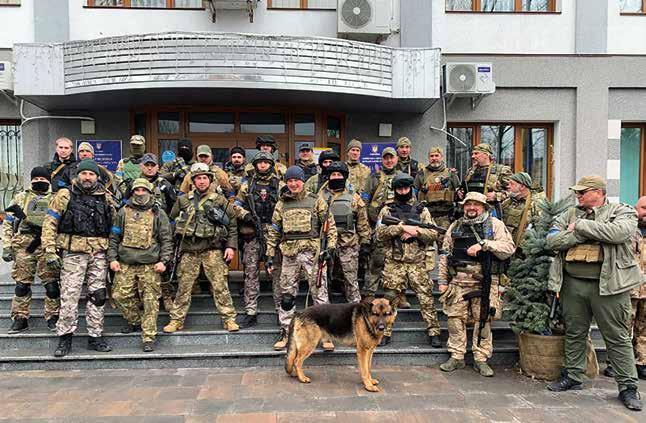
A lot of countries in the West and elsewhere, led by the U.S. and the U.K., have been providing tremendous arms sup port. But Ukraine wants more help; they want fighter planes, they want ships. They want the sorts of things that the West is just not going to give them because the United States, for one, is simply not going to make the kinds of moves that are going to walk itself into a direct war with Russia.
How do you think this war will change the Ukraine you’ve known for the last two decades?
A lot of people are going to come back from the front lines determined to make sure that what they fought for and what their friends died for will mean something. The galvanizing of the national spirit that Ukraine has under gone can only have positive effects for the country once the war is over. I think Ukraine has a new sense of itself.
Celia Aniskovich ’10 considers herself primarily a documentary filmmaker, with credits including Beanie Mania, Fear City, Mafia Tapes, Fruitcake Fraud, Surviving Jeffrey, and the upcoming Burn it Down! — about the ill-fated Woodstock ’99 festival — on HBO and other outlets. For an early job, she joined the crew of the TV spy series The Americans. But podcasting seemed the best medium to tell the story of Maria Butina, the young Russian who began visiting the U.S. in 2015 to befriend conservatives, especially those in the gun culture, as a way (she claimed) to enhance the relationship between the two countries. The U.S. government viewed Butina more suspiciously, arresting her as an illegal agent of Russia, imprisoning, and deporting her. Aniskovich spoke about her new podcast series Spy Affair, about Butina, with Michael Matros.

what I do skews more toward storytelling. I also was aware of how much Maria’s looks and sexuality played into how the story was reported in a way I felt was really beside the point and would not have been harped on in the way it was if she were a man.
In one of the podcast episodes, Maria said, “I may be naive, but I’m not stupid.” With her grounding in history and philosophy and so on, she’s definitely not stupid. But is she naive?
I do not think Maria is naive or a damsel in distress. I don’t think she is someone who is easily duped.
You’ve spent a lot of time with Maria, in person at her prison, on the phone, and even after she returned to Russia. Do you like her?
I do like Maria. She was very accommodat ing, and I never got the sense she was trying to hide anything from me.
You met some fascinating characters as your story developed. One was Maria’s lawyer, Bob Driscoll. Bob was like everyone in Spy Affair. Every one is a character, and everyone has their own motivations. He was worried about
some people talking to Maria and getting caught up in a ‘sexy spy story.’ He was inter ested in the idea that someone could relate to Maria — a female reporter, someone her age. Quite frankly, Maria was in prison and needed someone to talk to.
What surprised you about Maria and her story?
Objectively, she was fairly sentenced inso far as the sentence matched the sentencing guidelines associated with the crime she was convicted of. However, I do wonder if she would have gotten a different sentence under different circumstances — if she wasn’t Russian, if her cause wasn’t guns, if she wasn’t a beautiful woman who posed on the covers of glossy magazines in provoca tive clothing, etc.
Would you say there is a distinctive Celia Aniskovich style?
The thing that unifies my work is you will never see black and white in something I do. I don’t believe we should be defined by our worst day or our best day. Asking someone to share their story is one of the most vul nerable things you can ask, so I try to remind myself that what I do is a privilege and comes with a big responsibility.
How did you decide to pursue the Maria Butina story?
I tell a lot of stories about women, particu larly women who have become the subject of headlines, and I am always interested in the way women are depicted in the media. I don’t really think of myself as a journalist, and I think it’s an important distinction. I am obviously interested in the facts, but I think

Garry Trudeau ’66 Simon & Schuster, Boxed set with flash drive, user manual, and poster
To get a glimpse into the entire dramatis personae of Garry Trudeau ’66 , open the substantial lid of Dbury@50 : The Com plete Digital Doonesbury and first unfold
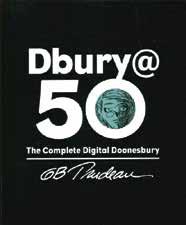
the commemorative poster, featuring 63 familiar faces. God isn’t among them, but of course Mr. Butts is.
The Dbury@50 boxed set comes with an industrial-quality USB flash drive loaded with almost every daily and Sunday car toon from the strip’s initial syndication in 1970 (a few seem to have been misplaced in the archives) through June 2020 — from “Mike meets B.D.” up to “Trump observes pandemic deaths.”
Casual readers might need a refresher about J.J.’s sleazeball boyfriend, Zeke, or the résumé of Honey, Duke’s ever-suffering assis tant and co-founder of Nothing But Orphans Home for Foundlings. The flash drive offers detailed biographies of all the principal play ers, from Alex to Zonker. Some may remember when Jeff Redfern, aka the Red Rascal, accidentally shot down a USO tour helicopter. Others might recall the time Zonker purchased his eminent title of Viscount St. Austell-in-the-Moor Biggleswade-Brixham. No? Well, just click the thumbnail of the young cannabis entrepreneur.
We are warned at the “Strips by Year” home page that “This is a network of rabbit holes,” and indeed it is. Let’s go way back to 1974. There’s “Watergate conspirators reunion,” “John Denver drives Duke crazy,” and “Leonard the Talking Frog is back.” And then on to 2017: “Minty pot for black gay stoners,” “Jan has a Sarah Palin action doll,” and “Doonesbury, safest space in comics.”
Accompanying the digital content is The Complete Digital Doonesbury User Manual, its 224 pages recapping the highlights of each year, with trivia items and representative illustra tions. The book shows how, unlike those of most other cartoons, the characters age, acquiring additional facial details through the years, morphing from the rough sketches Trudeau first penned in those early, just-out-of-Yale cartoons into characters with more realistic and expressive features.
Dbury@50 is a graphic compendium of American cultural, social, and political history in the guise of comic relief. It’s not always for the faint of heart (e.g., Duke is zombified), but it is always full of heart.
Because our Fathers Lied: A Memoir of Truth and Family, from Vietnam to Today

Craig McNamara ’69 Little, Brown and Company, 2022 Craig McNamara ’69 came of age in the political tumult and upheaval of the late 1960s. While the SPS alumnus would grow up to take part in anti-war demonstrations, his father, Robert McNamara, served as John F. Kennedy’s sec retary of defense and the architect of the Vietnam War. This searching and revealing memoir offers an intimate picture of one father and son at pivotal periods in Ameri can history. Because Our Fathers Lied is more than a family story — it is a story about America and the story of the war from the perspective of one American family.
 John Shattuck ’61, Sushma Raman, and Mathias Risse
John Shattuck ’61, Sushma Raman, and Mathias Risse
The New Press, 2022 Americans agree human rights are essential to their freedom, and that rights today are severe ly threatened. The promise of rights has been reimagined at pivotal moments in American history — from the American Revolution to the Civil Rights Movement. Can today be come another time of transformation? Hold ing Together is about the promise of rights as a source of American identity, the struggle to re alize rights by Americans to whom the promise has been unfulfilled, and the way forward in which rights can bring Americans together. The authors present a comprehensive account of the current state of rights in the United States, and offer concrete recommendations to policy makers and citizens on how to reclaim them.

S. E. Thompson, Jr. ’62 Cascara Publishing, 2022
Where would you go with no status quo? What to say to one who’s blasé? Want your ex-boss dealt a last coup de grâce? These are just some of the more than 4,000 delightful foreign words and phrases defined in this book. Readers can enhance their con versational skills by using the tools provided in these chapters, arranged by language and subject. Exotic English documents colorful foreign expressions from Spanish, Italian, French, Latin, Greek, German, Yiddish, and Japanese. This is the only book where seekers can find the vast majority of the foreign words and phrases in current use, presented in an entertaining and accessible manner.
spshorae.com
Pieter Fossel ’10 remembers it well. Two plants, equal in height and size, standing side by side, indistinguishable to the naked eye.
“Then the engineer brought out a thermal camera,” he explains of his visit to NASA’s Goddard Space Flight Center in Greenbelt, Maryland. Fossel had traveled to meet with a leading scientist of the Landsat Missions, a group of


eight Earth-observing satellites that uses remote sensors to collect data for the U.S. Geological Survey. “We were blown away. We could see the difference in temperature between a well-watered plant and an unwatered one, even though they looked identical. We thought, ‘What if we could blanket the Earth with a constellation of sensors and measure water stress in near-real time from space?’”
Space was foremost in his mind when Fossel co-founded Hydrosat, a D.C.-based startup that compiles high-resolu tion thermal and infrared imagery of Earth’s increasingly hot surface. Since its 2017 launch, the company has closed on more than $17 million in venture funding to commer cialize an analytics product that measures ground tem perature and for a constellation of satellites that produces a global thermal infrared map — primary source material when it comes to the ever-shifting story of wildlife patterns, severe drought, and the perils of climate change.
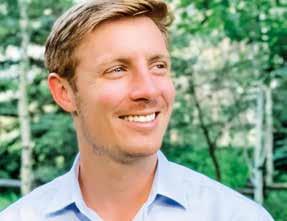

Many have bought in. Clients include the U.S. Depart ment of Defense, the U.S. Air Force, and the European Space Agency.
“When you think about the founding of Earth Day in the 1970s, it was a direct result of the Apollo missions and the unprecedented views and pictures that astronauts were
With the startup satellite company Hydrosat, Pieter Fossel ’10 is helping to map climate change.
gathering from space,” says Fossel, who serves as Hydrosat’s CEO. “Seeing the planet in its entirety and how humans have an impact has a way of putting things into perspective that feels much different than seeing it on the ground.”
Hydrosat’s beginnings have roots at St. Paul’s School, and Fossel credits much of his passion for climate action to Bill McKibben, the author, environmentalist, and founder of Third Act, a nonprofit that organizes people over the age of 60 to act on issues of climate change. McKibben spent time as a guest lecturer in Fossel’s Fifth Form Humanities class and later skied with Fossel during Nordic team practices.
“His visit had a profound impact on me and got me to care about the environment,” Fossel says. “It ultimately influenced my study of water and clean technology issues at Georgetown and shaped my decision to found Hydrosat.”
As receding freshwater levels, record-setting heat, and obscure weather patterns dominate headlines, Fossel and his fledgling enterprise have plans for more. Starting next year, Hydrosat will begin to launch 16 satellites that scan the globe daily for data, with the goal of making it acces sible to those who want or need it, and has several more contracts in the works. Next up: the first of what Fossel

hopes will be many Hydrosat-engineered satellites with proprietary technology that orbit Earth’s atmosphere.


“We are focused on doing as much good as we can in a world that is only getting more complex,” Fossel says. “One of the things I learned at St. Paul’s was to shoot for the stars. I never imagined I would take it so literally.”

These formnotes reflect information re ceived through June 30, 2022. Please send news/photos of yourself or other alumni for these pages to: Formnotes Editor, Alumni Horae, St. Paul’s School, 325 Pleasant Street, Concord, N.H. 03301 or alumni@sps.edu.
Jim Kinnear was the guest speaker and honoree at the 2022 Memorial Day service held in the cemetery of St. Peter’s Church in Millbrook, New York. David Parshall ’65 shared that, in his remarks, Jim relayed to a captivated congregation many of the specif ics and risks that are a part of wartime mil itary activity and spoke of his own person al experiences in the Korean War, in which he served our country in three consecutive tours, earning seven Engagement Stars and a Navy Commendation Medal. He also recited from memory some of the words of the Navy recessional hymn: “The Son of God goes forth to war … who follows in his train?” At the end of his remarks, as he looked out over the cemetery where veterans dating back to the American Revolution are buried, Jim re turned to that question and answered it with these concluding lines of the hymn: “O God, to us may grace be giv’n to follow in their train.” Overall, it was a most moving address and the congregation acknowledged it with a standing ovation.
other COVID-delayed forms. We were joined by Mark’s daughter, Lisa Cluett Thors ’83, and by Fergie’s son, Fergus Reid ’81. They helped us navigate the weekend whenever we needed.
A note from Steve Gurney on Anniversary Weekend: “Three loyal formmates — Fergie Reid, Mark Cluett and Steve Gurney — re turned to Millville for Anniversary on June 11. Back in 1951 at age 18, who among us could have imagined a reunion 70 years in our future? But SPS proved they still care for us, and warmly welcomed our small band with a terrific weekend. We shared it with several
On arrival, we were struck, but should not have been, by the School’s familiar appear ance; its red brick walks and bright lawns and careful plantings mowed and groomed even better than those we left so many decades ago. There are changes, of course. The Big Study, where Rector Henry Kittredge artfully conducted Morning Reports in his muchimitated yet respected gravelly voice, burned in 1961. The Old Middle, where Laurie McCagg housed his pet horned owl and behind which he kept his vintage fire engine, to be started up and driven by Herb Church ’40 on occasional Sunday afternoons, has been replaced by a suitable 20th-century white clapboard upgrade. The New Upper is named for the Rev. Henry Coit, the School’s first Rector, and has an additional dining room. The Halcyon and Shattuck boathouses on Long Pond were moved, reassembled, and preserved in form and tradition in their Tur key Pond location; at this Anniversary, the School celebrated a century and a half of SPS rowing. While many of us have seen these changes on earlier visits, we noticed them more on this one, likely our last in this world. And there are 50 years of talented and ac complished women graduates of the School in our midst.
As we walked by the Lower School Pond just behind the beautiful library, it might also be noted that we were looking out at the very birthplace of ice hockey in the United States — that’s where Hobey Baker (Form of 1909) trained by himself, sometimes at night, to be come the nation’s top hockey player. A few feet
away, we walked over ground where the first squash courts in the United States had been built in 1883. We can note that both sports were introduced from Canada by the Rev. James P. Conover, Form of 1876, then a faculty member, to balance the rigors of high scholar ship with the rigors of competitive exercise.
Each of us found ourselves flooded and re warded with indelible memories of what, for some, were among the best years of our lives. We learned, we grew, we laughed. Now, de cades after, we proudly marched, unassisted, at the head of the Alumni Parade. And, finally, the Chapel, with its 20 stained glass windows, whose beauty taught us how to Pray for the Peace of Jerusalem and inspired us to sing Love Divine and our Last Night Hymn and even to remember the School Prayer’s words.”
The Form of 1952 reunion for your reporter began in Claverack, New York, on the eve ning before we arrived in Concord. Tom Charlton ’56 and his son (Tom), Ludmila and I were all guests for lunch and dinner at the farm of my (and Tom’s) Yale class mate Caldwell B. Esselstyn (aka ‘Essy’). Also present were Bill Becklean and his charm ing wife. What did we all have in common? Appropriately enough, as we were on the way to celebrate 150 years of rowing at SPS, the answer is crew. Essy rowed 6, Tommy rowed bow and captained, and Bill coxed the Yale varsity, which won gold at the 1956 Olympic Games in Melbourne. What was I doing there? I had the dubious honor of rowing in the junior varsity crew that chased that Olympic boat the season before it qualified to represent the United States.
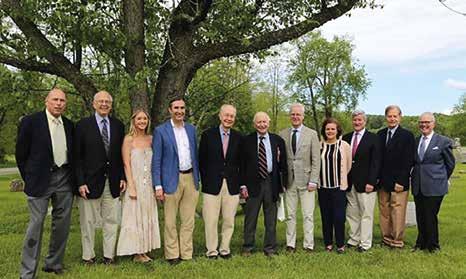
In The Wizard of Oz, it’s the tornado that sets the story in motion, lifting Dorothy up and away from her Kansas home to the Land of Oz.
That same tornado also set in motion the career of meteorologist Brent Scudder ’56 after he saw it on screen as an eight-yearold. Though it frightened him, the twister also captured his imagination and ultimate ly whirled him to the ends of the Earth and back again before dropping him on the door step of Dorothy’s home state as an octogenar ian storm chaser.
Sitting in his Toyota Highlander on the side of the road near Wichita Falls, Texas, Scudder peered at the radar on his laptop. He’d hoped to see his first tornado on that spring 2021 day, but after driving three hours west to chase one that was predicted to blow up in the area, he no longer saw any sign of a storm.
Another false alarm was disappointing — but not surprising — after three seasons of attempts. The U.S. records about 1,200 torna does a year, but when you’re one man in an SUV on the Great Plains, where the roads are long and straight and the wrong choice at an intersection can send you miles away from
your target, the odds are against being in the right place at the right time.
Calling off his search for the day, Scudder checked into a hotel. Then, the television alerted him to a tornado watch for Altus, Oklahoma, 90 minutes away. Close enough. Back into the Highlander, with its bumper sticker proclaiming “The Enemy is Ennui.”
“I got near Altus and the clouds were so thick and the rain so heavy I didn’t think I’d see anything,” Scudder says. “I was halfway back to the hotel when the cloud formations got very interesting. I looked to the west and saw a tornado about 10 miles away. It stayed on the ground maybe 20 seconds.”
Then Scudder, hoping the tornado would come down again, did something he calls stupid — he decided to get closer.
“I ran into the biggest hailstorm I ever saw,” he says. “The hail was the size of base balls. It cracked my windshield and put dents in the car.”
After three seasons and tens of thousands of miles, endless hours of too-calm weather, and countless decisions about where to find a tor nado, one had found him. It was the culmina tion of a desire that had been gathering force in Scudder for three-quarters of a century.
As a student at St. Paul’s School, his inter est in weather had been strong enough for a vice rector to notice and put him in charge of the weather station. At Kenyon College, Scudder majored in physics and entered the Air Force ROTC program, which sent him to weather school. His time in Ohio, on the edge of Tornado Alley, dissolved his childhood fear of twisters and left only the awe he’d felt as a boy watching Dorothy’s house fly away.
After earning a master’s in meteorology at New York University, Scudder spent 15 months at Byrd Station in Antarctica gather ing data on the upper atmosphere. Most of the rest of his career was on the East Coast; he went into airline dispatching after 20 years in industrial meteorology creating forecasts for private companies and retired soon after 9/11. The desire to see a tornado “kind of festered” for many years, but he couldn’t find time for the pursuit. After his second wife died in 2017, Scudder had the money and time for storm chasing.
“There I was, at the age of 80,” says Scud der, who plans to write a book about his con tinuing adventures, “starting to chase storms when really I should only be using my car to go to the post office.”

Brent Scudder ’56 is too busy to be bored — he has tornadoes to chase.MICHAEL SEAMANS
We had a lovely evening at Essy’s recalling old pals no longer with us and listening to the replay of the broadcast of the gold medal race. Unfortunately, only seven of us were able to make it back to Concord. Tom and Tom Jr., Fred Hoppin, Ala Reid (Breezy Reid’s wid ow), Stan Rinehart (and Carolyn), David Sinkler (and Becky) and Peter Wells (and Karin). Several other formmates did write to ask that their best wishes be conveyed to all and to convey news of themselves.
The first day began for us with a celebration of 150 years of rowing at SPS, where we chris tened the latest shell acquired by the School as the Form of 1952. That evening, we shared a dinner table with the Form of 1951, which included Breezy’s brother, Fergus Reid ’51
The next day, we walked in the traditional Alumni Parade and, after lunch, many of us meandered out to Turkey Pond, where we looked at many recently acquired shells. They sure do not look anything like those in which we rowed so many years ago. Unfortunately, Tommy could not take his Olympic form out on the water, but with some trepidation, your reporter did take a row. It was interest ing how after not too many “paddles” row ing memory kicked in and it became fun. Of course, getting out of the shell was a bit more
difficult than it was some 68 years ago, but we all managed and made our way back to SPS for a pleasant farewell dinner. Thanks to all at the School who worked so hard to make the weekend the smashing success it was.
died since the last such service was read. Late in the afternoon, a shell went out on Turkey Pond with our classmates Wadsworth at 3 and Baldwin at 2; it returned nearly an hour later. Saturday’s dinner was held at the re modeled Hargate, now known as the Fried man Community Center, where we and the other forms in our group were addressed by Rector Kathy Giles.
Over the weekend of June 10-12, golf carts ferried many of us to events at all points of the grounds, and the service to graduates and visitors was impeccable. Our own Form of ’55 was gathered together with forms from ’67 and before, all the way to the lone graduate of the Form of 1945. Our turnout in an off year was impressive. The following arrived, ambulatory and in good spirits: Baldwin, Lovejoy, Nichol, Horan, Hurlbut, Shaw, Wadsworth, Webber, and Wilmerding, most with spouses, and assembled for dinner on Friday night at the new dining room in the remodeled Upper. On Saturday morning, we met in the Chapel for services and the roll of those who had
On Friday afternoon at the incredible ath letic center, some of us old oarsmen, includ ing Frank Lloyd, met to hear a presentation reflecting on the 150 years that rowing has been an important part of the School’s iden tity. The weather was sunny and warm and the grounds and buildings, old and new, were perfectly groomed. We all left feeling the positive effects of the School’s efforts to make us feel welcome and with renewed interest in our old friends and the School itself. Surely there were some among us who shared that lump in the throat and wiped a tear of nos talgia when the Chapel tower chimed and the words of familiar prayers were read. Trees we remembered as much smaller shaded the well-maintained pathways. Familiar build ings we lived in 67 years ago were impecca bly maintained or missing, replaced by beau tifully designed buildings on a campus that radiates the excellence of our school.
Henry Armistead was awarded the 2021 Volunteer of the Year Award by Blackwater National Wildlife Refuge in April 2022.
Form Directors Allan Ayers and Guy Rutherfurd say that it’s time for the greatest class to think about our 65th reunion. The tentative plan is to do a pre-event at the York Harbor Inn. If anyone has any thoughts about what you’d like to do while we’re there, now is the time to let us know. By the time you see this, we already will have been talking to many of you to get a feel for your plans and any other thoughts.
 1960 Dimitri Sevastopoulo dsevastopoulo@gmail.com
1960 Dimitri Sevastopoulo dsevastopoulo@gmail.com
The Form of 1960 gathered for a convivial lunch and spirited conversation on May 12 at the Harvard Club of New York. Joining the

In May, formmates Haven Pell, Mike How ard, and Tony Parker (along with friend Ross Dierdorff) took a four-day sailing trip down the Chesapeake Bay from Annapolis, Maryland, to Norfolk, Virginia, on Tony’s sailboat, Reindeer. Haven reports on their adventure in a blog post at pundificator.com/ the-old-men-and-the-bay.
Subsequent to that excellent adventure, Rufus Botzow sailed his boat up the Bay and met Tony in Annapolis for Sunday breakfast on the waterfront. He also was treated to a tour of the fantastic new house Tony and Claire are building and use of the Annapo lis Yacht Club’s fine facilities for a shave and shower. Rufus shares of his boat, “I keep it at Stingray Point in Deltaville, about two and a half hours from Charlottesville. Next sum mer, I hope to take it Down East, Tony’s for mer turf and where I sailed as a boy.”
Ted Baehr wrote to share the passing of his beloved wife, Lili, on May 5.
From Peter Otis: “In May, I returned to Mill ville with an architect/author friend who is


writing about New England buildings and the quarries that provided their stone. Part of our focus for that trip was SPS and Sheldon Library, with its granite from Rattlesnake Hill in West Concord. As we dug through the archives in Ohrstrom Library, I finally re alized something that had not been evident to me for 60 years. ‘Millville’ as a section of Concord refers to mills that existed along the Turkey River, including the site where Shel don is located today.”

Pete Meyer writes: “I retired going on three years ago. I miss the folks I worked with and the challenges of fixing airplanes, but not lay ing in a puddle with jet fuel or Skydrol drip ping on me while the rain and wind are howl ing. Took up surfing last summer and plan on continuing to learn this year and more.”
Ken Williams is retired and living a tranquil life in Newark, Delaware. He is in regular contact with Rob Porter and David “Jake” Askins ’75. He is hoping to convene a get-
together this summer with Ed Shockley and Peter Patton ’73.
From Tina Miller: “I was asked to tell my story as part of the School’s 50-year celebra tion of coeducation. I was a part of the original planning committee back in April 2019, along with Sally Keating ’72. I was also an integral part of the 25th celebration back in 1996. Unfortunately, 2020 hit with COVID, loss of family, jobs, and direction, which continued well into 2021 and, somehow, I was left out of the events of 2021. As new people became part of the discussion, I somehow got lost in the shuffle. So, imagine my surprise when I got an invitation to one of the first events focusing on early women of color. I made sure to be on the call as well as the after-Zoom party. Besides the participants, I connected with Dorien Nunez ’75 and former faculty member Char lene Clinton, among others. It was bright light in a dismal time.

In March, I participated in another SPS event, A Virtual Fireside Chat with Ted Landsmark ’64 and Michel Martin ’76, which provided me an opportunity to reconnect with many alumni and friends. As May ap proached, I decided to go home for my first Mother’s Day celebration with my family since 2019. Several days before, I started hav ing chest pains and pain radiating down my left arm. I was rushed to the ER and it was determined that the cause was a combination of stress and anxiety. As a COVID survivor, I have suffered from bouts of fatigue and respi ratory problems. As the result of the intrave nous steroids that were used to save my life, I went from pre-diabetic to diabetic. With a clean bill of health, I made plans to return for Anniversary Weekend.
Even though this was not my reunion year, I was extremely excited about Anniversary
spshorae.com
2022. Due to COVID, the Forms of 1972, 1975, 1976, and 1977 would all be there to cel ebrate. Additionally, it was the culmination of the celebration of 50 years coeducation. Since I was there during the early planning stages more than three years ago, it was important for me to be there for the final events. The one I looked forward to most was the panel discussion with current and former female teachers called “50 years of SPS Women in the World.” I was also interested in several events that were sponsored by affinity groups, but my greatest joy was being able to reconnect with Charlene Clinton, my SPS head of house, mentor, and friend. We were last together in person at my 45th reunion, where she was one of our form’s faculty guests.
Ms. Clinton is the perfect representation of all that 50 years of coeducation represents — a woman of color who came to St. Paul’s a youthful faculty member who simply needed a job after completing her master’s in Spanish. Charlene and I started Saturday morning at Concord’s newest hotspot (Tucker’s) and popped in on every event scheduled for that day, including having dinner with Bert Lewars ’77 and Earl Potts ’77
As a result of the DEIJ meet and greet, we were introduced to a number of faculty



of color and well as variety of affinity groups that comprise students and staff of color. One of my best memories was having a conversa tion with the faculty adviser for Onyx, where we were able to commiserate about the ear ly days of St. Paul’s for students of color. We provided them a glimpse of what was like for people of color in Concord and at St. Paul’s. I was not only reminded of the friends and faculty who provided me with some of my life lessons, but for those who are no longer with us, especially Robert Hipp ’72 (my old boy), Michael Russell ’72, Rodney Williams ’73, Jose Wiltshire ’73, Lee Ella Bouton ’73, and Vanessa Bowens ’75. We talked about the lost ones — including my old roommate, Loretta Jacobs ’74.”
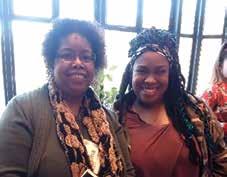
Jeremy Smith shares: “I can’t make it to re union because I’m at Marshall Space Flight working on the SLS rocket. Right in the re union timeframe, we’re rolling the vehicle back to the launch pad and taking a run at Wet Dress Rehearsal (tanking and count down test), so we’re pretty much working around the clock until that’s complete. If that goes well, we’ll be gearing up to launch later
this year, so no time off for a while. Hopefully I’ll make our 50th.”
Cari and Carl Lovejoy welcomed their fifth granddaughter to the family. Annabelle Hud son Lovejoy, daughter of their youngest son, Nick, and his wife, Meg, was born on June 8 and weighed in at a whopping 5 lbs., 5 oz.
Tony Bullock tony.bullock@ogilvygr.com Alison Zetterquist zettera.az@gmail.com
From Alison Zetterquist: “Being a co-form director with Tony Bullock has afforded me not only the terrific opportunity to collabo rate with him, but a way to rekindle friend ships from SPS days and build relationships with those great people whom I didn’t really know. Now imagine seeing many in person — and in one place. Anniversary Weekend gave me time with 18 formmates, as well as members of other forms. We missed seeing the current students on campus, but so many said it was great to spend time with people from other forms, too. Beyond my form mates, I had wonderful talks with Blaine Carter ’75, in particular, and other ’75ers during our joint dinner on Saturday night. Just this morning, I spent time on the phone with Josh Gould ’77, following up on con versations during Anniversary. All in all, a memorable weekend.”
Tony Bullock shares: “It was great to see so many formmates and to reconnect and reminisce. The joint dinner with the Form of ’75 was the highlight of the weekend. Happy to see that the Olympic roofball court be hind Center Upper has been renovated and was getting plenty of use. Let’s have an even stronger showing for our 50th.”
Alison Swift and Liz Maxwell-Schmidt got together in Phoenix recently as Alison and her husband, Dan, just moved to the area and Liz and her husband, Steve, were spending a cou ple of weeks at their house in Peoria, Arizona.

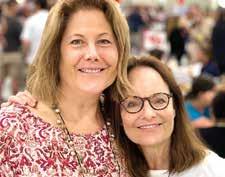
Chris Willis writes: “During Anniversary Weekend, while a bunch of ’77s were having a great time at the dam, a boat comprised of alumni from the Forms of ’75 to ’78 had a blast ‘sitting down going backwards,’ (to quote Cliff Gillespie). Given our age and that it was our first time rowing together, we had the boat set up really well, did a racing start, and a series of power pieces, receiving huge accolades from the coaches who witnessed the action. From the stern, starting with cox swain Leo Arnaboldi, were rowers Kevin Foley ’78 , Spencer Fulweiler ’76 , Mike Ives ’76, Phil Wallis, me, Blaine Carter ’75, Jim Brown ’76, and Didi (Bradley) Blau.”
1978/45th Nora Tracy Phillips noratphil@aol.com Jon Sweet Jsweet1000@gmail.comFollowing up on the news John Tweedy re ported in the previous issue of Alumni Horae

regarding the documentary film on the his tory and current reality of living Black in Boulder, Colorado, that he; his wife, Beret Strong; and their co-director, Katrina Miller, recently released, John is justifiably proud and honored to tell us that along with the other awards the film had already earned, This is (Not) Who We Are was named win ner of a Special Recognition Award when it aired at the Boston Film Festival this past spring. John also tells us: “My wife and I just got back from walking the Camino de Santi ago, starting at St. Jean Pied-de-Port on the French/Spanish border and ending in Muxia on the northwest Spanish coast, via the an cient [pilgrimage] destination of Santiago de Compostela, a pilgrimage on foot of 550 miles over 45 days. I recommend it to anyone seeking a life-changing experience.”
Lita Remsen tells us: “A healthy handful of us ’78s found our way to Millville for this year’s unique Anniversary Weekend. This year’s Sixth Form and the Form of 2020 (in cluding Jon Sweet’s eldest son, Harrison ’20) had separate graduation ceremonies during the week before we descended upon the School. And since the forms whose gradua tion years end in 0, 1, 5, and 6 were unable to have their reunions over the past two years, many from those years joined the forms end ing in 2 and 7 for some fun multi-aged gath ering. While it was great to be back on cam pus this June, it will be ’78’s turn to celebrate our 45th reunion next spring.”

From Chip Olney: “Not a ‘round’ reunion year for any of us ’78s, but because I now live in New London, New Hampshire, so close to Concord, I showed up at SPS for the memorial service for Cliff Gillespie and the 150 Years of Rowing symposium/shell christening, took part in the reunion row (those ’07s must have got tired pulling me around), and crashed the
’77 dinner and jam. It was great to see form mates Earle Simpson, Lita Remsen, Jon (and Tiffany) Sweet, and Kevin Foley. I’m sorry I missed seeing Linda Richards and Katie Thayer McCammond, who I hear were there, too.”
A note from Graham Galloway: “A lot of changes on my end. After 31 years in Atlanta, we just sold our home and moved full-time to our beach house at Fripp Island, South Carolina. We are finalizing plans to build our final home (hopefully) at North Topsail Beach, North Carolina, which is about 30 minutes north of Wilmington. I am still a se nior partner in the biopharmaceutical prac tice at Spencer Stuart, the global executive recruiting firm, and plan to begin working at a lower gear as I prepare to retire at the end of 2025 after 27 years in the profession. My goal is to retire before I reach seven million Delta miles. On the personal front, my kids still live in Australia. My daughter, Ashton (34), lives in Darwin on the north coast and my son, Grayson (31), lives in Margaret River, two hours south of Perth on the west coast. I have been very happily married to my amazing wife, Yu-Chieh Wang Galloway, for six years. We have known each other for more than 20

years, having met at Spencer Stuart back in 2001. We have three Australian Shepherds, Taz, Kylie, and Torie, who keep us busy and bring us much joy. Finally, after years of ‘trending to portly,’ I finally got serious about my health about a year ago and started an in tense exercise and fasting routine. Fourteen months and 3.4 million meters on the rowing machine later, I have lost 78 pounds.”

More than 30 members of the Form of 1981 attended Anniversary Weekend, with a live ly off-campus party at the Follansbee Inn in Sutton on Saturday evening — a solid show ing for a non-reunion year. Four came from California and one from his home aboard a sailing catamaran.


We had an outstanding crew for a race against the Form of 2020, powered by Ned Doubleday, Peter Paine, David Janney, Brooke Southall, Sam Reid, Matthew Mor gan, Nina Streeter, and Stacy Jamar Caf frey. After a long absence, Matthew gets the award for best smile and hair.
Several attended Cliff Gillespie’s memorial
service, and were happy to see Sue Gillespie celebrate her father, whose lasting impact as a teacher, coach, and mentor meant a great deal to many of us.
Perhaps some of the form Zoom gatherings over the past couple of years helped to stim ulate interest in seeing each other live. Our form has an eclectic and welcoming nature, and the weekend provided a lovely way to en joy the bonds we share. And we like to dance.
Polly Wakeman writes: “Thank you for sharing your reflections and gratitude. I was delighted to help facilitate this gathering of our very special form. It was such a joy see ing everyone having such great fun together. From the stimulating conversations to the enthusiastic dancing, I can’t help but smile. I hope our unique bond continues to inspire our commitment to coming together in the years to come.”
From Lixy Carey: “My best memory was sitting around the Harkness table in the Fol lansbee Inn dining room on Sunday morning for three hours, laughing and telling stories with the stragglers. We learned that Brooke and Sam were actually hooligans when they were students.”
Andrew Binger shares: “It was fantastic to see all of you at a very special place to all of us. Sorry I suffered a traumatic roofball injury. (I’ve given up trying to explain myself to others!)”
Reza Dana writes: “I am, as always, so moved by spending these few days with you all. For me, always more moving than my college, med school, or graduate school reunions. The singularity of our experience so many years ago in that era of the late ’70s throws one back to a dreamy nostalgia that takes a few days to wear off.”
1983/40th Icy Frantz icy@icyfrantz.comStill saddened by the news of the passing of Cam Sanders Sandy Hertz shared a lovely piece of remembrance with our class. We send our sincere condolences to Cam’s family and to the many communities of friends impacted by his wonderful and talented presence.
From Stewart Murchie: “All is well in West Hartford. Getting close to an empty nest, which will be different. I get to see Alan Murchie ’81 more frequently now, as he has also moved here. West Hartford just became

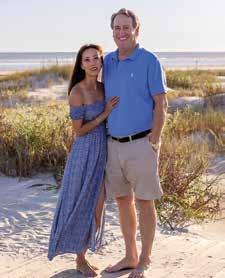
one of the most sarcastic towns in the U.S. as a result. During COVID, I turned to LSD: Long, Solo, Depthful walks, which are now a permanent habit — 4,000 miles since the start of COVID. Under the influence of this kind of LSD, I hallucinated a novel, loosely based on events involving others from the Form of 1983. The novel, marginally better than the drivel I used to hand in for Mike Burns’s creative writing class, is being revised. It’s been good to connect with SPS friends periodically over the last couple of years, in cluding our form Zooms and some collective social media ranting. It is a reminder of what a collection of worldly, kind, and thoughtful people we went to school with.”
Fiona Sanders visited Dan Grout’s broth er’s distillery, Harvest Spirits, on their family farm, Golden Harvest, in Valatie, New York. Great stop off l-90 between Massachusetts and Albany. In addition to the grain-free vodka, Fiona swears it was the best BBQ she ever had.

Where in the world is Michael J. Stubbs? Well, he has just returned from Svalbard, which he circumnavigated through sea ice just north of the 80th parallel (High Arctic) and experienced close-up encounters with polar bears, walruses, seals, and reindeer.
1986 Harold Bost hbost2@me.com Helen Fairman hfairman@comcast.net
Helen Fairman writes: “A small, intrepid band —six members — of the Form of 1986 gathered in Millville in June to celebrate the form’s 35th, which took place virtually last summer. Cee Cee Gammon Belford, Helen Fairman, Chuck Fedolfi, Darryl Harding, Nick Stern (whose band, FOUR TRACK, entertained the crowd on Friday night), and Amy Sullivan took full advantage of this year’s unusual format by immediately cam paigning for adoption by the Form of 1987. The ’87 contingent kindly embraced their el ders as honorary formmates, welcoming us to virtually all of their Anniversary activities. A hearty thank you from ’86 to ’87 — here’s hoping we have an opportunity to recipro cate someday.”
Nick Stern shares: “It was a joy to bring my band, FOUR TRACK (@four_track_rock), to this unique Anniversary Weekend and per form for a multi-form gathering on Friday night inside the giant reunion tent. Paulies showed their terrific spirit and enthusiasm —

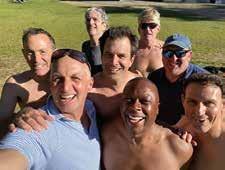

Friends from 1986 at post-Anniversary events in Concord were (l. to r.) Nick Stern, Cee Cee Gammon Belford, Helen Fairman, and Amy Sullivan.
dancing, cheering, and, thanks to Eric Che hab ’87, jumping on stage and whipping up a Big Red frenzy. It seems like yesterday he was playing Danny Zuko in Grease. It was a limited ’86 gathering (we seem to be besieged by pandemics and natural disasters for recent big reunion years), but the Form of ’87 wel comed us into their raucous 35th gathering. As always, being back in Millville was emo tional; it was so wonderful to return and so hard to leave. We are truly blessed to have had those years together. Particular thanks to Amy Sullivan, Helen Fairman, Cee Cee Gammon Belford, Darryl Harding and my dearest old pal, Chuck Fedolfi, for attending and being the great souls they are. Personal note: I closed the construction operations of my company, Stern Projects, in 2020. While I have a few real estate development projects in the works, my passion for my second 50 (thanks to Will Muecke for coining that one) is music. I’m fortunate to have fallen in with an extended group of very talented lifelong NYC musicians and I play with them as both a sideman (bass guitar) for jam sessions as well as gigs. It’s an amazing journey, and I’m going wherever it takes me.”

Imagine furniture that’s trendy yet timeless, affordable yet considerate of the environment. While this combination might seem too good to be true, Sabai Design CEO and co-founder Phantila Phataraprasit ’12 offers selections that check all the boxes.

Phataraprasit’s inspiration for her sustainable furniture company rests on environmental durability and a desire to create comfortable, stylish spaces that “don’t sacrifice your values.”
“There’s been a shift in my generation,” she says. “People want to create a space of comfort at the end of the day — or during the day when they’re working from home — and I found that was difficult for a young professional on a budget.”
Phataraprasit was further motivated after learning about the furniture industry’s impact on the planet. She discovered that millions of tons of furniture waste end up in landfills every year, and she grew increasingly concerned about the harmful chemicals that seep into unsuspecting consumers’ skin, as well as the amount of fuel wasted by shipping imported materials across the world.
“My mom ran eco-lodges, and I grew up learning about climate change and pollution,” says Phataraprasit, who was raised in Bangkok. “I’ve been focused on sustainability in my own life, like buying secondhand clothing and eating less meat.”
After earning her B.A. in economics and political sci ence from Columbia University in 2016 (she completed her J.D. at NYU School of Law in 2020), Phataraprasit and her co-founder, Caitlin Ellen, launched Sabai Design
in 2019. The pair had initially worked together in college to found Columbia’s first credit union. Since teaming up for a second time, their company has grown steadily.
Sabai Design’s made-to-order furniture uses recycled and upcycled fabrics and plastic-free shipping. Because materials are sourced locally, the company experienced less disruption to its supply chain during the pandemic. Instead of waiting three or four months for furniture orders from most companies, Sabai’s customers typically waited only four weeks for delivery.
In addition to its mission of sustainability, Sabai prior itizes design, craftsmanship, and accessibility. And Pha taraprasit is especially proud of two programs — Repair Don’t Replace and Sabai Revive — that reduce the amount of furniture sent to landfills. With a focus on extending the life of items, Repair Don’t Replace allows customers to take their furnishings apart and replace only the damaged or unwanted segments. (Imagine your pet destroys the arm of your sofa — instead of trashing the entire piece, you can simply buy a new arm.) With Sabai Revive, the company guarantees it will take back a piece of furniture, resell it, and give the customer a portion of the proceeds.
Phataraprasit cherishes the positive customer feedback she’s received, and says it validates her business and moti vates her on hard days.
“There’s no roadmap,” she says. “It’s my responsibility to make things happen, and that’s the unique thing about managing my own company. It’s daunting, but also exciting and fun.”
1988/35th Caroline La Voie carolinelavoie@me.com
1993/30th Phoebe Lindsay pde.lindsay@gmail.com
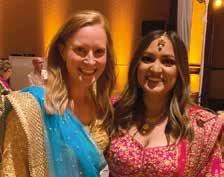

1998/25th Will Dick wcdick@gmail.com
Gabe Boyers shares: “Hello, NYC SPS friends. Just prior to the pandemic, I closed my art gallery in Boston and relocated to NYC to open a new gallery early in 2020. But the world had other plans. This September, I am excited to finally be opening this new space here in Brooklyn, which will deal in contemporary as well as earlier period art, plus rare books and manuscripts. I’d love to connect with any old friends living or pass ing through NYC and see any of you at our show openings. If you are interested, please join our mailing list (www.bdrygoods.com) or follow us on Instagram (@bdrygoods).”
2003/20th Melody Lam melody.lam@gmail.com
2007 Peter Harrison peter.harrison.g@gmail.com
Carrie Read and Nolan Jennings got mar ried at a ranch outside Park City, Utah, on March 26. Carrie is a director at BlackRock and Nolan is a film and television editor. They reside in Brooklyn Heights, New York.

2008/15th Dorothy MacAusland dmacausland@gmail.com
Fifty years after the release of David Bowie’s LP, The Rise and Fall of Ziggy Stardust and the Spiders From Mars, a space-themed concept album titled Come Now, Earthling! has been launched into the musical cosmos by singersongwriter Will Duncan. The collection addresses the possibility of our flight from Earth against the backdrop of an all-too-
plausible climate apocalypse and marks Duncan’s first effort in the role of producer. Streaming in all dimensions, and available on CD through Bandcamp and at willduncanmusic .com/store, the album will serve as the basis for a fictional prose narrative that Duncan is currently developing. In Bowie’s words: “Let all the children boogie!”
 2013/10th Beth Anne George elisabeth_george@brown.edu
2018/5th Haley Fuller hefuller@me.com
2013/10th Beth Anne George elisabeth_george@brown.edu
2018/5th Haley Fuller hefuller@me.com
Aidan Spencer was named an Ashe Award Sports Scholar 2022 for crew at Hobart and William Smith Colleges. Matthew Deegan and Rohan Mundiya graduated from Tufts University in May. Next year, Matthew will be teaching English in Madrid, while Rohan will continue his studies in Japan.
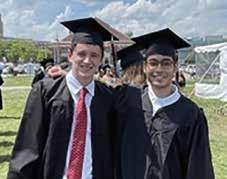
The section was updated June 24, 2022. Please note that deaths are reported as we receive notice of them. Therefore, alumni dates of death are not always reported chronologically.
1942 — Frederic Clark Hood II April 19, 2022
1945 — Joseph Bailey Hartmeyer
June 24, 2022
1946 — Paul Gray Brown May 21, 2022
1947 — William Hurlbut Force
“Bill” Spencer May 15, 2022
1956 — John Frelinghuysen
“Jack” Talmage II May 25, 2022
1960 — Peter M. Nicholas May 14, 2022

1964 — Charles Pillsbury
“Chuck” Resor April 24, 2022
1976 — Mark L. Rhodes
April 1, 2022
1983 — Cameron H. “Cam” Sanders May 6, 2022
1989 — Andrew Franklin Alexander Dec. 31, 2021
2016 — Giacomo Alexander Roberts May 27, 2022
Elizabeth Barrett “Betty” Murray June 3, 2022
Honor your friends and loved ones in Alumni Horae. Send a copy of an obituary, your own written tribute, a note listing a few facts about the deceased. We also request that you send a photo for inclusion.
Email the information and highresolution photos to alumni@sps.edu.
Route, and in many trips around the U.S. When he finally left New York after 50 years, he took the train to California.
Thomas W. Streeter a man who will be remembered for his loyal ty, wit, community spirit, and wide knowl edge, died on April 5, 2022, in Pacific Grove, California, at the age of 100.

Born on Feb. 23, 1922, in New York City and raised in Morristown, New Jersey, Mr. Streeter was the son of Thomas W. Streeter, Sr. of the Form of 1900 and Ruth C. Streeter. He enrolled at St. Paul’s School as a Second Former in the fall of 1935. At SPS, Mr. Street er competed with Old Hundred and Halcyon and was a member of Phi Beta Kappa.
He earned an A.B. from Dartmouth Col lege in 1946 and a combined M.S. in engi neering and business administration from Dartmouth’s Thayer School in 1948.
Mr. Streeter interrupted his studies to en list in the OSS, the predecessor of the CIA, soon after Pearl Harbor, and served in Bur ma, China, and India, developing and install ing code machines and serving as message center chief in Calcutta.
He used his engineering degree in his work at American Optical and then the Diehl Company. From 1964 on, Mr. Streeter fol lowed the business path and worked until 1999 on Wall Street with the firms G.C. Haas, Haas Securities Corporation (where he was chairman and partner), Bear Stearns, and Seligmann Harris (the first U.K. company to trade on the New York Stock Exchange.) He concluded his 40-year career at Ernst & Co. as a well-respected compliance officer.
Mr. Streeter and his wife, Barbara, traveled widely — Peru in the 1950s; Greece, Turkey, Lebanon, and Egypt in the early ’60s; and the Galapagos and East and South Africa in the ’70s. His interest in trains (the couple’s first date in 1946 was a drive to Vermont to watch the engines) influenced many of their travel choices, and Mr. Streeter continued to pur sue interesting train trips into the 1990s on the Trans-Siberian Railway, along the Spice
Mr. Streeter was a faithful churchgoer his whole life, serving as warden or treasurer at most parishes. In his thirties, he took French horn lessons and with his then-adolescent daughter, Mary, and joined the Plainfield Symphony Orchestra. Mr. Streeter was a life long lover and patron of music, with a season seat near the front at the New York City Op era and the Metropolitan Opera.
He was proud of his SPS family legacy, which included his father as well as his son, Thomas ’66; his uncle, Charles Paine Cheney of the Form of 1888; his brothers, Frank ’36 and Henry ’38; a nephew, Frank Streeter ’78; and a niece, Nina Streeter ’81.
Among other talents, Mr. Streeter was a great storyteller. At public events, he would often quote his three “rules for living:” never argue over the lunch bill; buy cheap, sell dear; and never take anyone for granted. He was a faithful consumer of obituaries and would read them aloud to his children at the dinner table. We hope this one does him honor.
Mr. Streeter was predeceased by his be loved wife, Barbara. He leaves his daughter, Mary, and her husband, Dick; his son, Thom as ’66, and his wife, Kristine; his daughter, Deborah, and her husband, Ron; five grand children; and nine great-grandchildren.
Frederic Clark Hood II a fair-minded man of strong character and remarkable resiliency in the face of adversity, died peacefully in his sleep on April 19, 2022, at his home in Dartmouth, Massachusetts, following several years of declining health. He was 97.
Mr. Hood was born in Brookline, Massa chusetts, on July 17, 1924, the eldest of three children of Donald Tucker Hood and Alva
Stacy (Brown) Hood. He attended Dexter School before enrolling at St. Paul’s School as a Second Former in the fall of 1937.
He served in the Pacific during World War II, before graduating from Harvard in 1947. After working in a pulp mill in Washington State, Mr. Hood returned to Cambridge to attend Harvard Business School, graduating with his MBA in 1950.
In the summer of 1949, Mr. Hood married Johanna “Nonnie” Seaver. The following year, the couple moved to Corning, New York, where he worked for the next 37 years for Corning Glass in virtually every capacity, from production, cost accounting, market re search, and recruiting to community econom ic development. By 1960, the Hood family had grown to include four sons and a daughter.
In 1987, Mr. Hood retired from Corning, and Nonnie from running the local Head Start program, to move to Dartmouth. After nearly four decades away, Mr. Hood rebuilt his connection to Southeastern Massachu setts through the boards of Community Nurse Home Care and Dartmouth Natural Resources Trust and through volunteering as a docent at the New Bedford Whaling Museum, an institution of particular inter est to him. He became a museum trustee in 1997 and established The Uriel Fund for care and conservation of works of art in the collection in 2000. He became board secre tary in 2002 and also served on numerous board committees.
Mr. Hood came from people who were farmers, weavers, sea captains, soldiers, mer chants, and manufacturers. His outlook was shaped by the Edwardian world of his par ents, the challenges and hardships of the Great Depression and World War II, and a bedrock sense of decency. He instilled in his five children a belief in the necessity of ser vice and stewardship.
Mr. Hood was predeceased by Nonnie, his wife and best friend of 71 years, and by his sisters, Elizabeth “Betty” Hood Pigford and Alva “Vee” Hood Angle. He is survived by his children and their spouses: Tucker Hood ’68 and Cathleen Hood, Rick and Leigh Hood, John Hood ’73 and Deebie Symmes, Holly Hood Hughes ’75 and Ian Hughes ’76, and Edwin and Molly Hood; nine grandchildren, including Timothy Hood ’15; an extended family of nieces and nephews and their children; and many friends.
a veteran of the U.S. Marine Corps, who served during the Korean War, died on May 21, 2022, surrounded by his family. He was 94 and a resident of Boston.

Born in Boston on Sept. 30, 1927, he was one of six children of Waldo and Frances Gray Brown. After attending Milton Academy in Milton, Massachusetts, where he grew up, Mr. Brown entered St. Paul’s School as a Second Former in the fall of 1941. At SPS, he captained the hockey team and also competed in football, baseball, boxing, and squash. In addition, Mr. Brown was a mem ber of the Student Council and the Acolyte’s Guild, served as a supervisor, and sang with the Glee Club.
From SPS, Mr. Brown went to Yale, where he earned his B.S. in 1951. He then pursued a career in industrial sales.
He married Susan (Waterman) “Susie” Brown, and together the couple started their family in Stonington, Connecticut, before moving to East Greenwich, Rhode Island, where they lived for five years. The Browns became longtime residents of Duxbury, Massachusetts, where their children attended the Duxbury school system.
Mr. Brown loved the ocean and boats of all sizes. One of his favorite quotes was, “Believe me, my young friend, there is nothing — ab solutely nothing — half so much worth do ing as simply messing about in boats.”
In addition to his parents, Mr. Brown was predeceased by four of his siblings: Ann, John, Waldo ’48, and David. He is survived by his wife, Susie; his son, Paul Gray Brown, Jr., and his wife, Amy; his daughter, Susan “Sudie” Danaher, and her husband, Douglas; and his daughter, Sarah Mattivello and her husband, Joseph; grandchildren Elias and Henry Brown, Charlie and Janie Danaher, and Hannah and Nicholas Mattivello; and his sister, Frances Aeschliman.
died peacefully at home in Newport, Rhode Island, on May 15, 2022. He was 92.
Born in Newport on August 13, 1929, he was the son of Katherine Force Spencer and Major Lorillard Spencer III of the Form of 1903. He arrived at St. Paul’s School as a Sec ond Former in the fall of 1942. He sang in the Glee Club and competed with Isthmian and Shattuck.
Mr. Spencer went on to Yale, where he earned a B.S. in industrial administration in 1951. A Lieutenant JG in the U.S. Navy, he served from 1951 to 1954 as operations offi cer aboard the USS Hemminger.

Mr. Spencer began his career as an engi neer at Sikorsky Aircraft in Stratford, Con necticut, but found himself drawn to teach ing. He earned an M.S. from the University of Bridgeport in 1963 and taught mathemat ics at Roger Ludlowe High School in Fair field, Connecticut. He was married to Valerie Taylor from 1961 to 1991.
In 1973, Mr. Spencer retired to Antigua, West Indies, where he lived and chartered aboard the ketch Lion’s Paw. Ultimately, he returned home to Newport, where he lived his final years gratefully surrounded by fam ily and friends.
A man of many interests, Mr. Spencer was an avid birder and bridge player. He never missed a Sunday New York Times crossword puzzle and in 1983 authored a bilingual ref erence for French-American culinary termi nology, Market, Kitchen & Table
Mr. Spencer is survived by his sister-inlaw, Marjorie Potts Spencer; his daughter, Elizabeth Spencer Ciullo, and her husband, Wayne; his stepdaughters, Linda Burr Wales and Susan Colleen Taylor; his daughter-inlaw, Sandra Paonessa Spencer; eight grand children; and many nieces, nephews, and great-grandchildren. He was predeceased by
his son, William Force Spencer; his sister, Katherine Spencer Doherty; his brother, Ste phen Wolcott Spencer ’43; his brother-inlaw, Joseph H. Doherty; and his half-brother, Lorillard Suydam Spencer.
Critically, he was available when Peggy Bright came along. Ed considered their wed ding day — April 8, 1961 — to be the greatest of his life. He joined Springs Mills, Inc. in 1958 as a sales trainee and was stationed in New York, Boston, Montreal, San Francisco, and New York. Twenty years later, he was president of the Apparel Fabrics Division. When the U.S. textile industry collapsed in the mid-1980s, he created Barn Hill Compa ny, which sold high-end European fabric.
Edward Parish “Ed” Harding of York, Maine, died, reluctantly, at home with his family around him on April 4, 2022. The cause was what used to be referred to as “old age,” and he was aware that his aged body owed him nothing; he had demanded and received a lot from it in his 86 years. He lived in Greenwich, Connecticut, for 53 years and, more recently, in York.
Ed was born on Jan. 6, 1936, the second son of Charles Lewis Harding, Jr. of the Form of 1922 and Marie Parish Harding. He won dered why anyone in 1936 would want to bring a child into the world of the Depression and pending war but later appreciated the opportunities. He attended Miss Stoddart’s School for Very Little People in Locust Val ley, New York; George Mason School in Al exandria, Virginia; and Greenvale School in Brookville, New York, before enrolling at St. Paul’s School as a Second Former in the fall of 1949.
At SPS, he was a member of the Cadmean/ Concordian Society, served as a supervisor, and sang with the Glee Club. He was an ex ceptional athlete, competing with Delphian in baseball, football, hockey, and squash. As a Sixth Former, Mr. Harding was awarded the Gordon Medal as the School’s best athlete.
He went on to Harvard, where he received his A.B. in 1958. He returned to earn his A.M.P. from Harvard Business School in 1974.
After surviving numerous medical proce dures, Ed believed that “someone up there” was watching over him and became a devot ed church member. He served on the boards of Greenwich Country Day School and Stu dio in a School (40 years), and on the vestry of St. Barnabas Church in Greenwich. He also was an enthusiastic supporter of the School of Leadership Afghanistan. He served St. Paul’s School as a form director from 2009 to 2022 and was a member of the Alumni Association Executive Committee from 2012 to 2017.
An accomplished athlete throughout his life, Ed was an age-group national squash champion three times, ran a marathon, and spent countless hours chasing the wily trout and salmon. His other hobbies included de bating matters of great importance or true silliness with his grandchildren, splitting logs, digging post holes, swinging racquets of all sorts, and exploring the waters near his beloved York Harbor.
He is survived by his bride of 61 years, Margaret Bright “Peggy” Harding; three children, Margaret Harding “Mimi” Owen, Marie Parish Harding, and Edward Parish “Ned” Harding, Jr., and their spouses; his sister, Marie (Flash) Harding; a brother, Henry Harding, and his wife, Mary; six grandchildren, including Martie Curran ’12 (and her husband, Alberto Arnedo Ruiz), James Curran, Caroline and Maggie Owen, and Calais and Lizzie Harding; and two stepgrandchildren, Charles and Henry Sharpe. He was predeceased by his older brother, Charles Harding.
David Butler Vietor a lifelong sailor, yachtsman, and historian, died peacefully at home in Edgartown, Mas sachusetts, on Feb. 8, 2022. He was 80.
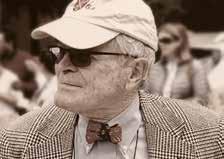
Born in New Haven, Connecticut, on Jan. 1, 1942, Mr. Vietor was the eldest child of Anna Glen Butler Vietor and Alexander Orr Vietor of the Form of 1932. He attended the Foote School before entering St. Paul’s School as a First Former in the fall of 1953 as the School’s youngest student. He competed with Delphian and Shattuck and was a member of the Glee Club and La Junta. He was awarded the Spanhoofd German Prize in 1958 and the Ambassador Duke Spanish Prize in 1959. Mr. Vietor received his B.A. in German from Yale in 1963 and his M.A. in German litera ture from Stanford in 1966.
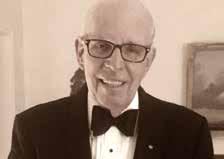
His life on the water would define him. His father taught Mr. Vietor and his younger brother, Richard ’60, to sail during their sum mers in Edgartown. There, David won virtu ally every trophy offered by the Edgartown Yacht Club, sailing in many types of boats and excelling at all levels of competition.
His success in yacht racing led to his first job at Hood Sails. He went on to race in 16 Newport-Bermuda Races and in most of the premier ocean racing events. He participated in two campaigns for the America’s Cup: the 1980 Clipper effort in Newport, Rhode Island, as tactician, and as CEO/skipper of the Coura geous effort in 1987 in Fremantle, Australia.
After years in the sail-making business, Mr. Vietor became director of the Acorn Foundation in New York and was involved in many philanthropic activities. He served on the board of the South Street Seaport Muse um and the President’s Council at Mystic Seaport and was a founding member of The Courageous Sailing Center in Boston.
After retiring to Edgartown, he served on the board of the Martha’s Vineyard Hospital and was president of the Duke’s County His torical Society. There, he continued his close friendships with many SPS friends who shared with him a love of sailing and life on the Vineyard.

Mr. Vietor is survived by his wife of 20 years, Nancy Blair Vietor, whom he first en countered on a port/starboard collision while racing 71 years ago; by his sons Andreas, Oliver ’89, and Edward; his daughters Susan Daughtry ’93 and Christina Osterman; his stepchildren Marshall Prida and Ethan Trask; and 16 grandchildren.
stock trading industry and became the larg est electronic stock trading firm in the world.
After retirement, Mr. Baxter committed himself to several organizations that were close to his heart. He served on the board of NatureBridge, an organization devoted to environmental education, a position he took in honor of his son, Matthew Andrews Bax ter III, who died in a rock-climbing accident in 1996 at the age of 26. He also served on the board of the Florence Griswold Museum. He served as treasurer and as a trustee of the Lyme Land Conservation Trust, as an over seer of the Amos Tuck School, and on the board of Vista Life Innovations.
were consequences. That has always seemed to be the biggest takeaway from SPS, and it has made my life seem easier at times, and I have always been grateful for that lesson.”
Matthew Andrews “Andy” Baxter a sitting trustee of St. Paul’s School and a true gentleman, died on Feb. 1, 2022, at 79 follow ing a yearlong battle with cancer. He was at his home in Lyme, Connecticut, with his family at his side.
Born in New York City on April 18, 1942, Mr. Baxter grew up in Cleveland, Ohio, where he attended the Hawken School. He enrolled at St. Paul’s School as a Second For mer in the fall of 1955. At SPS, he captained the hockey and lacrosse teams, played foot ball, and sang in the Choir. He was a member of the Concordian Literary Society, the Pro pylean Literary Society, the Dramatics Club, and the Acolyte’s Guild.
Mr. Baxter went on to earn his B.A. in philosophy from Yale in 1965 and, after eight years of selling insurance for The Equitable, earned his M.B.A. from Dartmouth’s Amos Tuck School of Business in 1973. He began his career in finance, serving in senior positions at Dreyfus Corporation just as mutual funds were taking off. Following his time at Dreyfus, he became vice chairman and COO of Instinet Corporation, which founded the electronic
Mr. Baxter also was generous with his time, knowledge, and resources as a trustee of St. Paul’s School. He joined the SPS Board in 2015, serving as chair of the Compensa tion Committee and on the Executive Com mittee. Rector Kathy Giles described him as “a trustee who came prepared, spoke his mind, and always kept the best interests of the School clearly in sight. Andy also was a marvelous man of intelligence, humility, good humor, and kindness.” He was a mem ber of the Hargate Society, an integral mem ber of the Form of 1960, and highly engaged in the alumni community. He also estab lished the Baxter Scholarship Fund, with a preference for providing financial assistance to students from New Hampshire.
In a 2017 Chapel Talk at the School, Mr. Baxter recounted a story from his Sixth Form year of how he and some friends had acci dentally shattered a window of the Chapel with a lacrosse ball. Justifiably scared, they immediately went to an administrator to confess their sin and later stood before the Rector for further recourse. The Rector gave the boys an appropriate punishment and, im pressed by their honesty, made their sentence more lenient.
“I have never felt that I had any difficulty differentiating right from wrong, recognizing when I faced something that I shouldn’t do, and I attribute that to St. Paul’s,” Mr. Baxter wrote to Alumni Horae several years ago, re calling the same incident. “While I am sure I learned some of it at home, and I certainly got other things from St. Paul’s, I have always believed that it was there that I really came to understand that the playing field had bound aries, that there were penalties, and that there
In 1984, Mr. Baxter married the love of his life, Carley Cunniff. They were devoted to one another for 21 years of matrimony. Through her battle with breast cancer and leading up to her death in 2005, he witnessed what quality end-of-life care could be. In her memory, and in recognition of Dr. Peter S. Dixon’s “good doctoring” at the end of Carley’s life, Mr. Bax ter created The Cunniff-Dixon Foundation with the mission of improving the art of med icine and surgery for people nearing the end of their lives. In a 2010 note to St. Paul’s School, Mr. Baxter wrote of the foundation: “It feels like it is probably the most useful thing I will have accomplished in my life.”
Indeed, the foundation has become a guiding light at the national level in honoring and enriching the physician-patient relation ship in late-stage illness, promoting the value of palliative/hospice care and recently creat ing Planning My Way, an advanced health care planning guide. The foundation’s princi ples and Dr. Dixon’s care enabled Mr. Baxter, as his wife before him, to die peacefully at home with family and loved ones at his side.
Mr. Baxter believed in doing everything to the fullest, whether it was working, running a marathon, playing cowboy pool, fishing, entertaining, or being a friend. Mentoring others was always rewarding to him. His wis dom and counsel, kindness and enthusiasm, and willingness to speak his mind will be sorely missed.
At a May 18, 2022, memorial service to celebrate Mr. Baxter’s life, friends recalled a man who lived with integrity, a competitive spirit, compassion, and selflessness. Through his words and his actions, they shared, he en gendered trust and good will.
“Andy’s generosity and dedication to im proving the lives of young people and those living in the twilight were nothing short of exemplary,” said Dimitri Sevastopoulo ’60. “To us friends who loved Andy, we were re warded in unique and heartwarming ways.”
Charlie Thomson ’60 spoke of meeting Mr. Baxter in the Third Form, of an enduring friendship that lasted throughout their lives, of travels together in the U.S. and abroad, and of many wonderful conversations.
spshorae.com
“He showed me how to live life to the ut most, whether on a trout stream or sitting in his beautiful yard under the giant elms,” Thomson said. “He always gave without counting the cost. He was a great gift, and I will remain grateful and carry him close.”
Mr. Baxter had two children with his first wife, Kate Baxter. He was predeceased by his son, Matthew Andrews Baxter III. He is sur vived by his daughter, Eliza Riley; two grand sons, Matthew and Huck; his sister, Anne Baxter, whom he considered his best friend; and many other family members and friends.
ian Literary Society, the Debate Team, and the Missionary Society and served as a su pervisor in his dorm. He attributed his un derstanding of the importance of personal discipline, hard work, and team play to his experiences at St. Paul’s.
Mr. Nicholas attended Duke University and earned a degree in economics in 1964. He met his future wife, Ginny, there, and they were married soon after graduation. Af ter college, he served two years as a junior officer in the U.S. Navy. He served a year on USS Lookout as Communications Officer and the next year in Little Creek, Virginia, as a member of the Navy Special Operations Warfare Group. He resigned his commission in 1966 to attend the Wharton School at the University of Pennsylvania, where he earned an MBA with honors in 1968. Pete and Gin ny spent more than 35 years living in Con cord, Massachusetts, with their three chil dren before moving to Boca Grande, Florida.
successful capital campaign in Duke’s history. They supported financial aid, libraries, pro fessorships, nursing, the medical center, ath letics, and more. One of their proudest con tributions was donating the founding gifts to create the Nicholas School of the Environ ment and the Nicholas Institute for Environ mental Policy Solutions. In 2021, Duke awarded Mr. Nicholas the University Medal for his lifetime of service to his alma mater.
Mr. Nicholas was an eternal optimist who loved his family first and foremost. He tinkered in his workshop, coached his children’s teams, helped others whenever he could, enjoyed Red Sox games, and was a passionate boater who loved cruising with Ginny, his extended family, and close friends. He also was an avid collector of 19th and 20th century marine art and a lover of carved Bellamy eagles.
a family man, respected businessman and co-founder of Boston Scientific, passionate boater, and involved philanthropist, died on May 14, 2022, in the arms of his wife of 58 years, Ginny Lilly Nicholas. He was two days shy of his 81st birthday.

Born in Portsmouth, New Hampshire, on May 16, 1941, he was the second son of Nicholas and Vrysula Nicholas, who were both born in Greece. As a child, Mr. Nicholas lived in Portsmouth; Portland, Maine; Groton, Connecticut; Belmont, Massachusetts; Copenhagen, Denmark; Virginia Beach, Virginia; and San Juan, Puerto Rico. During World War II, his mother and her four children often stayed with the larger Greek family in Pine Point, Maine, while his father, a commander, captained submarines for the U.S. Navy throughout the Pacific theater.
Mr. Nicholas enrolled at St. Paul’s School as a Third Former in the fall of 1956, where he lettered in baseball, football, and squash. He was a member of the Cadmean/Concord
Mr. Nicholas spent his early career at Eli Lilly & Company, progressing from sales to general manager of Scandinavia in his final four years with the company in Sweden and Denmark. Mr. Nicholas founded Boston Sci entific Corporation with his business part ner, John Abele. It was there that he discov ered his deep passion for building businesses, spending more than 35 years as co-founder, chairman of the board, and CEO while the company evolved from a start-up to a global enterprise that at its peak hit a $67 billion market capitalization with more than 41,000 employees. Mr. Nicholas spoke often of how he loved his relationships and experiences with the people that he knew because of Bos ton Scientific. Like so many entrepreneurs, Mr. Nicholas was unable to give up his inter est in building companies, and after retiring from Boston Scientific, he continued to work as managing director of Ithaka Partners, LLC, a private equity firm he created with his family.
Mr. Nicholas loved Duke University, and he and Ginny gave generously to the school. Over the course of decades, Mr. Nicholas volunteered in many roles, including Duke’s Trinity College board chair. Mr. and Mrs. Nicholas co-chaired what was then the most
Mr. Nicholas had a keen sense of the pub lic good. Those who knew him well described him as smart, understated, and curious about everything. He was relentless once he decid ed that a problem or opportunity needed tackling. He shared his success generously and primarily focused on education at all levels, inner city youth at risk, and maritime institutions.
He was a fellow of the American Academy of Arts & Sciences and former vice chair of the Academy Trust. He was a member of the American Academy of Achievement and a recipient of the Phoenix Lifetime Achieve ment Award, signifying distinguished lead ership and accomplishment in the medical device industry as well as the prestigious AdvaMed Industry Award (2016) for his pio neering role in the field of interventional medicine. He also was a recipient of the Ellis Island Medal of Honor and the Lifetime Achievement Award from the Wharton School of Business.
Mr. Nicholas is survived by his beloved wife, Ginny; their three children, JK, Nicho las, Jr. and his wife, Christy; and Katherine; his brother, Nick, and his wife, Lynn; Mr. Nicholas’s amazing large Greek family; Gin ny’s large and loving family; and seven grandchildren. He was predeceased by his twin sisters, Sally Monroe and Susan Johnsen.
Charles Pillsbury “Chuck” Resor a conservationist, youth sports advocate, and inventor, died on April 24, 2022, of pancreat ic cancer, at his home in Jackson, Wyoming. He was 75.
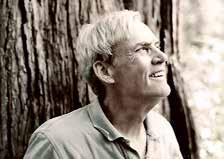
Born in New York City on Jan. 19, 1947, to Jane Lawler Pillsbury and Stanley Rogers Re sor, Mr. Resor was the second of seven broth ers. He made his first visit to his family’s ranch in Jackson Hole during the summer of 1948. His love for the Snake River Ranch, the valley that surrounded it, and community that filled it would shape his life and bring him back to the place that he would eventu ally call home.
The family moved to New Canaan, Con necticut, when Mr. Resor was young. From New Canaan Country Day, Mr. Resor entered St. Paul’s School as a Fourth Former in the fall of 1961. He played hockey with Isthmian and rowed with Shattuck. He earned his B.A. from Yale in 1969 and his J.D. from Yale Law School in 1975. After graduating college, he took a job with The City College of New York, help ing students in the Bronx earn GEDs. Though teaching granted him a deferment from the Vietnam War, watching his students be draft ed while he, the son of the sitting Secretary of the Army, was able to avoid mandatory ser vice, did not sit well with him. So, Mr. Resor volunteered for the infantry and became an Airborne Ranger. By the time Mr. Resor fin ished officer candidate training, the Army was only sending West Point graduates to Viet nam, so he never served overseas.
Following the Army and law school, he took a job clerking for a circuit court judge. It was during his work for an appellate court judge that Mr. Resor decided to move to Wyoming.
There he became integrally involved in helping the Snake River Ranch with land and planning issues. In the late 1970s, Mr. Resor spearheaded the legal opposition to a lawsuit filed by the sewage plant in Teton Village that would have allowed effluent to be discharged across the Snake River Ranch into the head waters of Fish Creek. Following an unexpect ed favorable court ruling, Mr. Resor en shrined the temporary legal victory by collecting downstream landowner signatures on a petition that designated Fish Creek as a Blue Ribbon Trout Stream, protecting the stream in perpetuity.
Soon after, Mr. Resor and a group of other conservation-minded Teton County resi dents joined and formed the Jackson Hole Alliance for Responsible Planning, known today as the Jackson Hole Conservation Alli ance. His most visible contribution to local conservation may be the role he played in preserving the Walton Ranch, which lies east of the Snake River along Highway 22. At the time, there wasn’t a legal mechanism to make such a large conservation gift without being hit by prohibitive gift taxes. Mr. Resor was able to come up with a solution to preserve the ranch and its iconic vistas forever.
In 1981, Mr. Resor married Nancy Nickel. They had two sons, Miller ’02, and Turner ’04. His dedication to his children would lead him in new directions. In 1989, Mr. Resor was appointed president of Jackson Youth Skating (JYS), founded by his mother. He oversaw JYS from its inception to its eventual home at the Snow King Center, for which he fundraised tirelessly. Mr. Resor instituted fi nancial aid in the program, ensuring that all budding figure skaters and hockey players had an opportunity to participate.
In 1994, Mr. Resor took a sabbatical from his law practice and never went back. He and his wife moved their family to northern Spain and found renewed joy for life in this year abroad. Back in the States, instead of re turning to law, he developed an educational device inspired by his math-challenged sons. In 2000, Mr. Resor released the Flashmaster, a device that taught and tested basic arithme tic tables. The handheld device, which essen tially replaced flashcards but allowed teach ers and parents to track students’ progress, sold successfully for 17 years. In his final years, Mr. Resor worked hard to turn the device into a free app compatible with all tablets.
Mr. Resor will be remembered for his hon esty, kindness, humility, uncompromising morals, dry sense of humor, toothy smile, inexplicable love for riding his bike up the Old Pass Road, unconventional restaurant orders, and much more.

In the months leading up to his death, Mr. Resor was surrounded by the love and sup port of his partner, Patricia Fontanini; his sons; his daughter-in-law; his brothers, Stan ley Resor ’63, Edmund Resor ’69, and John Resor; and many dear friends. He died as sto ically as he lived, comforting those by his side by telling them it was “really no big deal” and that he expected death to be like “a really good night’s sleep.”
Cameron H. “Cam” Sanders died peacefully on May 6, 2022, at his home in Los Angeles, after several years of living with cancer. He was 56.
Born on June 23, 1965, in Cincinnati, he spent early peripatetic years as a Foreign Ser vice child at his family’s postings in the Mid dle East, Europe, and Washington, D.C.
He enrolled at St. Paul’s School as a Fourth Former in the fall of 1980. At SPS, he was be loved for his humor, warmth, and remark able creativity. A talented pianist and singer, he won the School’s Keiser piano competi tion and prepared and performed a program of Gershwin for his Sixth Form Independent Study Project. He ran with the cross country team and was a dedicated member of the a cappella group Deli Line as well as Madrigals and the Choir.
Mr. Sanders earned his B.A. from Yale in 1988, where he acted in numerous plays, sang with the Spizzwinks, and generally set the community alight. He had a strong com mitment to social justice and was a leader in GLAD and ACT UP. He spent his junior year in Berlin.
After many years of acting and writing in New York City, he moved to Los Angeles, where he worked on script teams for several comedy shows, including Will and Grace; became a gourmet cook; and trained profes sionally as a photographer at Santa Monica College.
Mr. Sanders was a remarkable photojour nalist and portrait photographer. He was a longtime member of All Saints Church-Pasa dena and a dedicated baritone in its Canter bury Choir. He also was a passionate actor, tap dancer, swimmer, pianist, and writer; a serious Scrabble player; a champion cross word puzzler; and a dog adopter. Multifacet ed as he was, he may be best remembered as a true friend. He was a magnet for people and leaves behind beloved communities in all ar eas of his life.
Mr. Sanders was predeceased by his moth er, Betsy Sanders. He is survived by his father, Cameron H. Sanders, Jr.; his siblings, Helen Gray ’82, Marcia Loughran ’85, and Nick Sanders ’88; his extended family that in cludes David Loughran, Erika Erzberger, Ju lian Gray, and Kim Bender; his nieces and nephews, Jamie, Katherine, Emily, Jojo, Ben, Lillian, and Simon; his cherished Stafford shire terrier, Grace; and many loving aunts, uncles, cousins, and friends.
his first birthday, Mr. Roberts and his family moved to Groton, Connecticut. In 2001, he was joined by his greatest friend, his brother, Fabrizio. They both (along with his step-sister later on) attended the Regional Multicultural Magnet School in New London in the bilin gual program. By the time Mr. Roberts went to Cutler Middle School, he was fluent in Ital ian, Spanish, and English. For years, he served as his little brother’s unofficial translator on many trips to Italy to visit family.
Although music had been a joy of his from early years, Mr. Roberts started playing the alto saxophone in earnest in middle school through an outstanding band program. He played in the jazz band and spent a year at Fitch High School in the marching band.
Throughout his youth, he also played soccer, basketball, and lacrosse with the Groton rec reational programs. Lacrosse soon became his passion. He played varsity lacrosse his freshman year at Fitch, where he also was a top student. His intellect, wisdom, and char acter were noticed by all who met him.
He entered St Paul’s School as a Third For mer in the fall of 2012 and there he met some of his closest friends. He continued playing saxophone in the jazz ensemble and played lacrosse and ran cross country. As a Sixth Former, he won the Keiser Student Music Competition for composition. He graduated in 2016 and was accepted to the University of Richmond, which awarded him the Presi dential Scholarship.
that came through the city in the fall, he spent his first month each school year work ing with the National Guard to rescue and assist people stranded by Hurricanes Delta (2020) and Ida (2021). He felt great personal reward in being able to help the citizens of New Orleans impacted by these back-toback natural disasters.
Mr. Roberts was a loyal, caring, and sin cere friend who deeply connected with those who knew him. He will be remembered for his clever and keen wit, beautiful smile, dim ples, and infectious laugh. He had a sharp and inquisitive intellect, which came through in his writings, conversations, musical com position, and countless pursuits. He was a critical thinker who could speak meaning fully and passionately about multiple topics, including music, culture, and important so cietal issues. He traveled the world, fluently conversed in multiple languages from a very young age, and cared deeply and genuinely about others less fortunate than himself.
Mr. Roberts was very much involved in the Tulane addiction and recovery community from the time he returned to school after the Army. He made strong connections and met his best friends there. He completed his junior year and was scheduled to come home for va cation with his family on the day of his death.
2016 Giacomo Alexander Roberts a kind and genuine soul and a true gentle man, died unexpectedly on May 27, 2022. He was 24 years old.
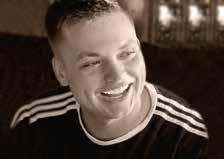
Born on July 8, 1997, in La Jolla, California, he spent his first year living in nearby Encini tas under the loving care of his parents, Luisa and Greg, and his beloved nonno, Enzo. Mr. Roberts’s first word was in Italian and, of course, was about food. In 1998, shortly after
He attended Richmond for his first year, but felt he needed more diversity and city life. He transferred to Tulane for his sophomore year, but independently realized he needed to get his “mind straight” and figure out what he wanted to do. Despite the trepidation of his parents, Mr. Roberts joined the U.S. Army as a chemical, biological, radiological, and nuclear specialist. Upon completing boot camp at Fort Jackson, South Carolina, he was stationed at Fort Drum in Watertown, New York, home to the famous 10th Mountain Division. His fam ily was never prouder of Mr. Roberts than when he served his community.
Upon completion of active duty, he re turned to Tulane to complete his education in international relations and English. He served in the Army National Guard while in New Orleans. Due to seasonal hurricanes
He is survived by his mother, Luisa Pac cagnella, and her husband, Robert; his father, Greg, and stepmother, Erika; his brother, Fabrizio, and sister, Seryn; and his grandpar ents, aunts, uncles, and cousins, whom he loved dearly and who will forever be better for his incredible and all-too-short presence in their lives. Mr. Roberts was predeceased by his beloved dogs, Kobi and Cruzer.
Legacy gifts change lives and transform institutions. Legacy gifts impact the student experience for generations. Legacy gifts allow you to share your values with the world. Legacy gifts protect the best of the past and nurture hope for the future. Simply put, legacy gifts make magic happen. Donors can use charitable remainder trusts, charitable gift annuities, life estates, qualified charitable distributions, life insurance, and more to strengthen SPS both now and in the future.
Please consider allowing us to help you develop a planned giving strategy that meets your philanthropic goals, minimizes your tax obligations, and protects your heirs.
To learn more, please contact: Phillip Blackman, director of leadership and planned giving, at 603-229-4781, pblackman@sps.edu.
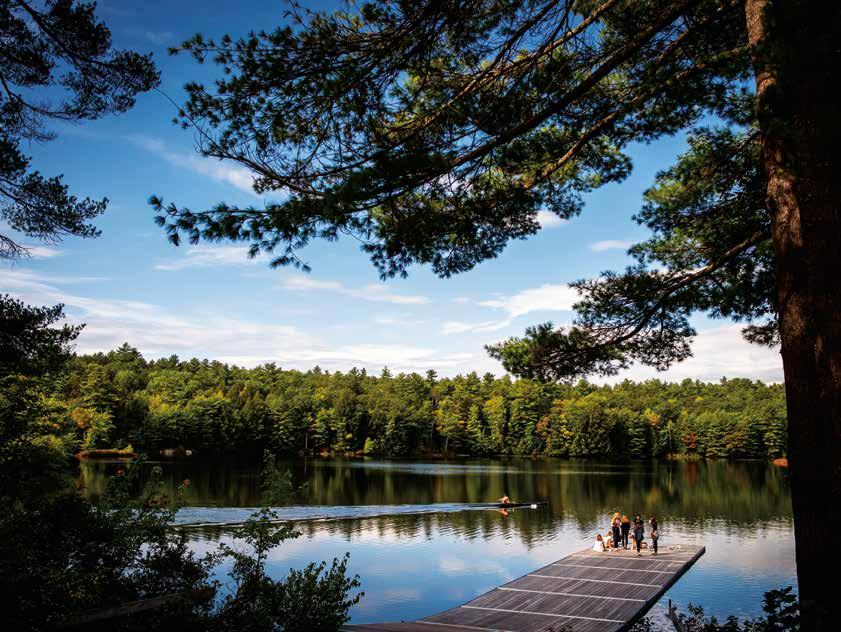
Over two weekends in May, alumni and parents gathered for a pair of SPS Sparks Days of Service to clean up communities in San Francisco; Philadelphia; Fairfield, Connecticut; the Greater Boston area; Brooklyn; and Manhattan. Together, the groups provided more than 100 hours of service, while cleaning wharfs, parks, and beaches.
“It was great to connect with others from across the years,” Caroline La Voie ’88, P’20,’21 said. “We spanned forms from the 1970s to 2021, shared stories, picked up trash, and had a lot of laughs along the way.”
SPS Sparks was founded by the Form of 1970 to offer opportunities for the St. Paul’s School community to col laboratively serve, collectively give back, and creatively share. This year’s efforts were led by a group of alumni and parents that included La Voie, Alison Manolovici Cody ’88, P’20,’22,’25, Caryn Cross Hawk ’76, P’09, Julia Fleischner P’20,’23, and Angie Martinez-Ramos P’17,’23.
“Sparks Days of Service,” Cody said, “are a great way to bring the entire SPS community together to make an impact on our local communities.”
In Philadelphia, a hardy contingent of members of the Form of 2020 reunited for the event, connecting with one another in person for the first time in two years. The young alumni partnered with older SPS graduates to per form a large-scale cleanup in the city’s Cobbs Creek area.

After participating in the San Francisco event while visiting son Shawn Hawk ’09 from Chicago, Cross Hawk added, “I encourage all alumni and parents to get involved in future Days of Service events as an opportunity to connect or reconnect with local Paulies while supporting local communities.”

In May, more than 190 alumnae gathered in 32 locations (18 states, two international, and two virtual) for the sixth annual XIX Society Global Seated Meal.




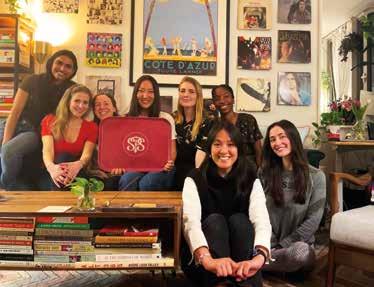



The event, created in 2017, echoes the longstanding SPS tradition of building community over a shared meal. In keeping with the Soci ety’s mission of connecting women across generations and geographies, alumnae are invited to honor that tradition while renewing old friendships and fostering new ones. Since its inception, more than 900 alumnae have gath ered together across the U.S. and the world.
Incoming Chair Madeline Wang ’93, P’21 shared that she loves the Global Seated Meal because it allows alumnae in different forms to connect with one another while breaking bread.
“Meeting and bonding with alumnae,” Wang said, “is such a uniquely joyful and valuable part of our lifelong SPS experience.”
Outgoing XIX Society Chair and Trustee Liz Robbins ’79, P’17 has attended three Global Seated Meals, one as a guest and two as a hostess, with women from the forms of 1976 through 2019.


“While we all shared a few traditions at SPS, including Seated Meal,” Robbins said, “it’s fascinating how we internalized those expe riences in different ways to grow into the re markable and diverse alumnae we are today.”

Alumnae also got together on June 11, during Anniversary Weekend, for a special XIX Society reception.

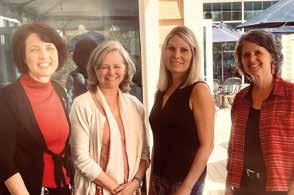

Steve Donovan joined the St. Paul’s School community as director of alumni relations in May, just weeks before the School’s first in-person Anniversary Weekend since 2019. His 35-year career has included alumni relations roles at the University of New Hampshire, Dartmouth College, and Case Western Reserve University — his alma mater. He comes to SPS from Trinity College, where he spent almost eight years as alumni relations director and got far too familiar with the route between Hartford, Connecticut, and his home in Durham, New Hampshire, where he lives with his wife, Molly, and 13-year-old black Lab, Bailey. He spoke with Kristin Duisberg.

What attracted you to SPS?
The opportunity to join a residential boarding school community has long been attractive to me, stemming back to my son’s own experience at one. To be able to do that at one of the world’s finest schools is a dream come true, particu larly so close to home in New Hampshire.
What are your first impressions of our alumni community?
I’ve been overwhelmed by how welcoming the entire community has been. I was for tunate to arrive just in time to experience Graduation and Anniversary Weekends. I had the opportunity to witness firsthand how appreciative students and their families were for their time at SPS. And then just a week end later, alumni from several Forms, includ ing the Form of 2020, who missed out on an in-person graduation, and came back to these beautiful grounds so excited to be with each other and the people and places that made their experience here so meaningful.
What has surprised you?
The most surprising thing has been how in credibly happy and friendly the faculty, staff, and students are. It’s hard to walk anywhere on the grounds and not have several people greet you warmly and with smiles. And while not a surprise, I am so impressed by the ex tremely talented team in Advancement and partners across campus. All are vital to the success of our alumni and parent engage ment efforts.
What are your goals for alumni relations at SPS?
First is to return to in-person alumni en gagement events and initiatives as we (hope fully!) come out of the pandemic. We’ll con tinue to build on the success of highlighting alumni via the virtual programs of the last few years, but there is no substitute for the desire of our community to come together in person. Second is to enhance the pride that
alumni feel for the accomplishments of their fellow alumni and also of SPS itself. There’s a significant role for alumni to play, and we’re eager to build a robust menu of engagement opportunities that alumni will find mutually beneficial. I look forward to meeting as many alumni as possible to hear their SPS stories, and to learn how together we can grow this legion of proud ambassadors and volunteers for SPS. I invite our alumni to reach out to me at sdonovan@sps.edu or (603) 229-4842.
The view of the Red Barn, Lindsay Center, and playing fields from my office in Alumni House is breathtaking and reminds me of what a stunningly beautiful campus this is. I text photos of it to family and friends! And the tradition and history steeped in the Upper is also remarkable.
Lab equipment in Lindsay and books in Ohrstrom Library. On-campus visitors and field trips off grounds. Financial aid. Athletic jerseys and ballet costumes. A fully residential experience full of possibility. Our deepest thanks.
This fiscal year, generous support from alumni, parents, friends, and others resulted in 4,797 gifts to The SPS Fund and $7.2 million that provides critical flexibility to the School in funding every facet of student life. The collective power of our community’s generosity ensures that every SPS student can take advantage of the exceptional experience that is St. Paul’s School.

Alumni Horae St. Paul’s School

Pleasant Street Concord, NH
Service Requested
Organization U.S. Postage PAID Concord, NH Permit No.